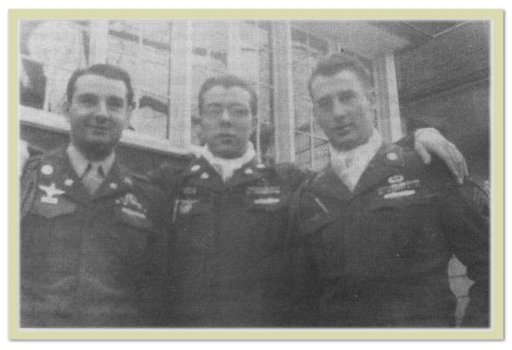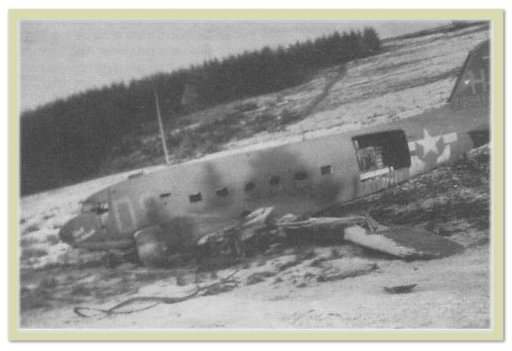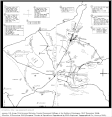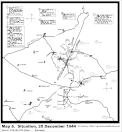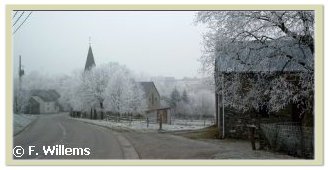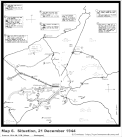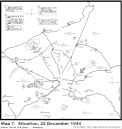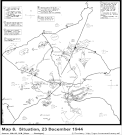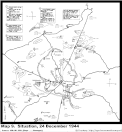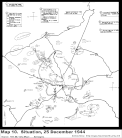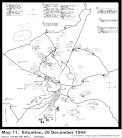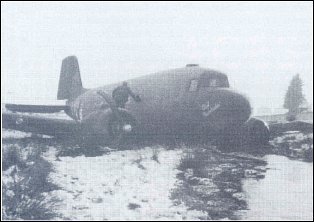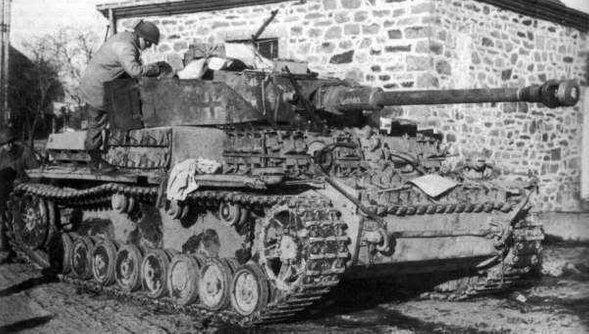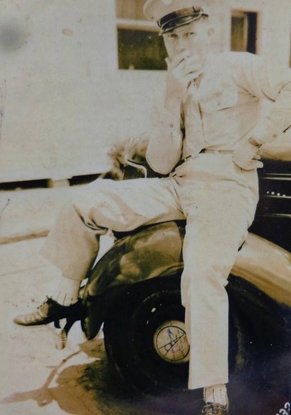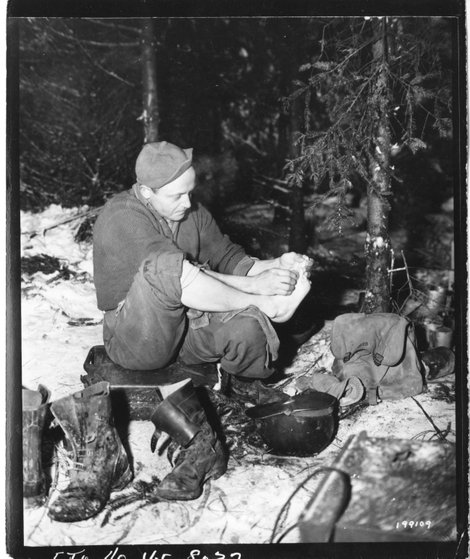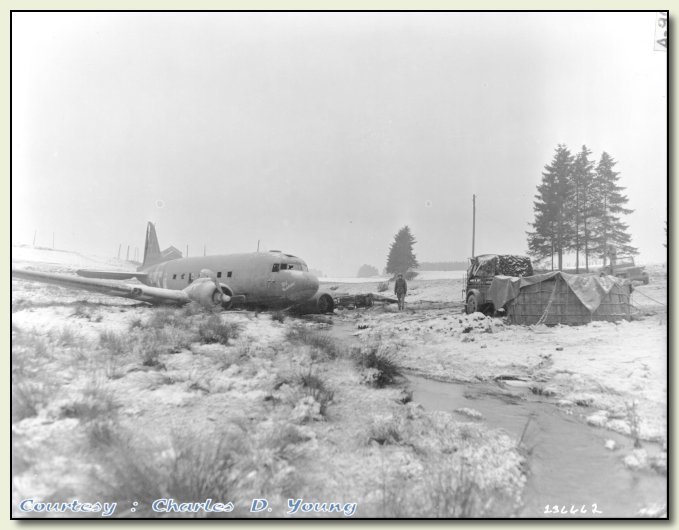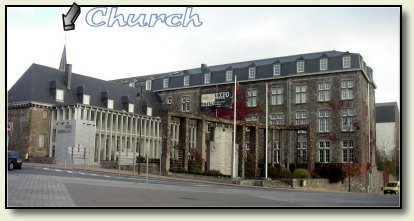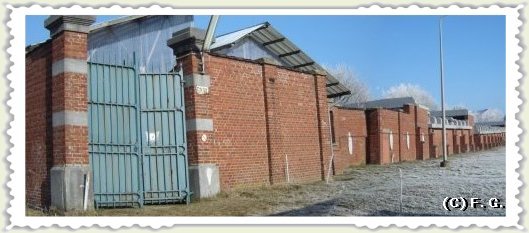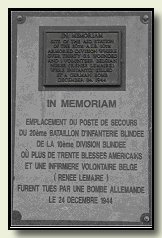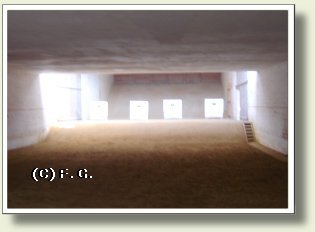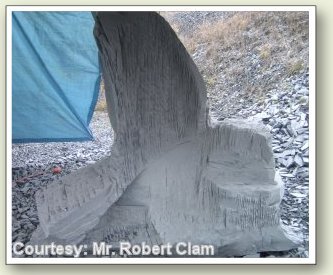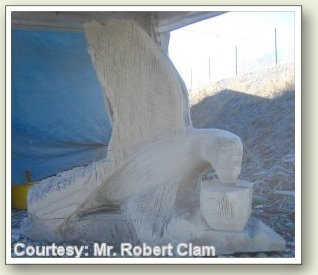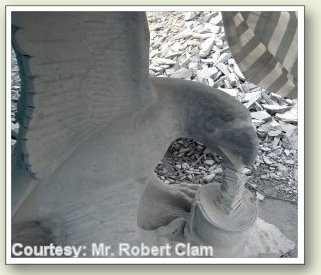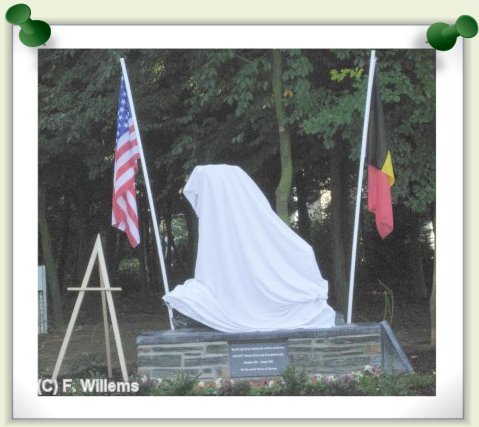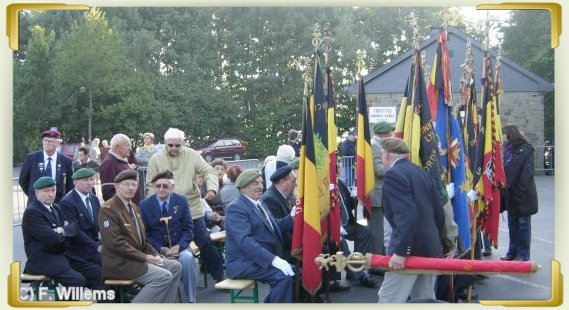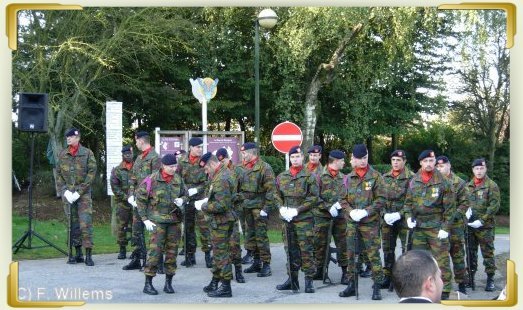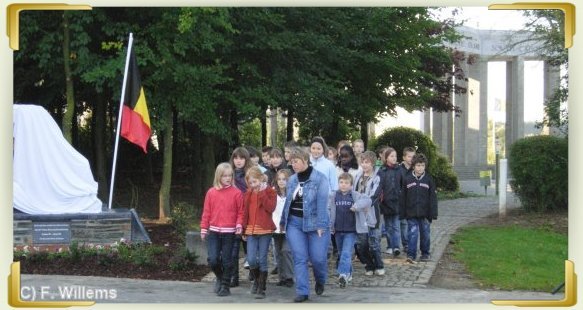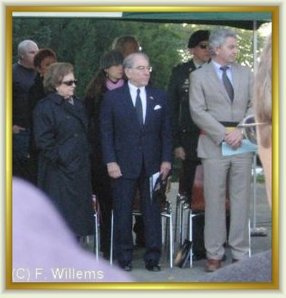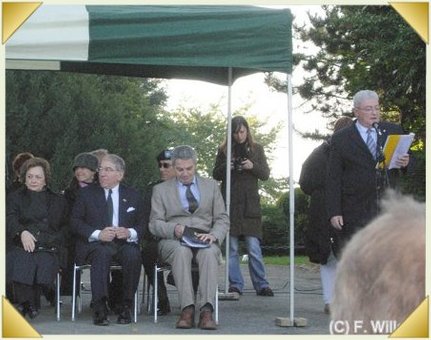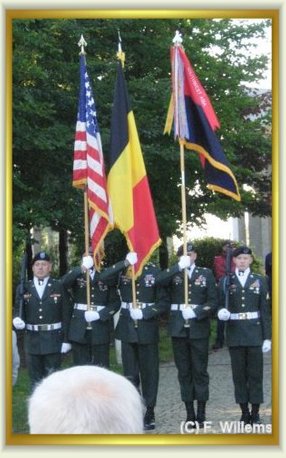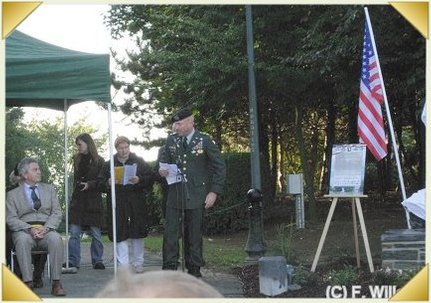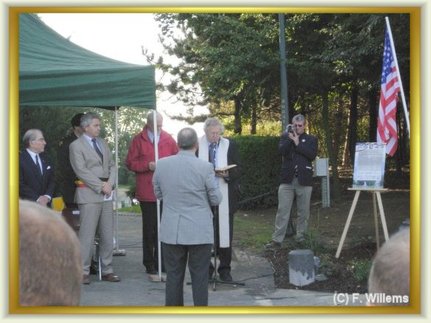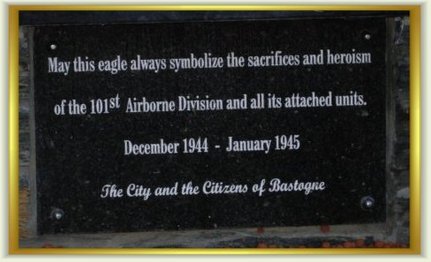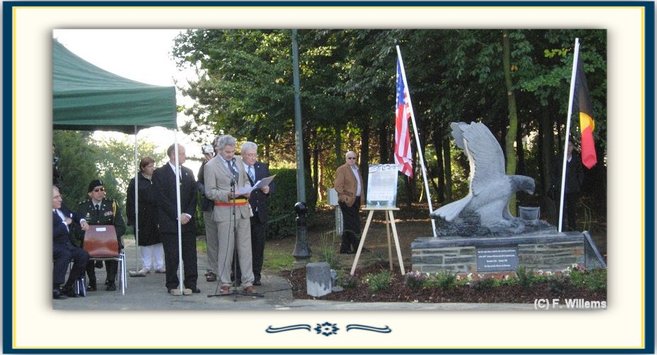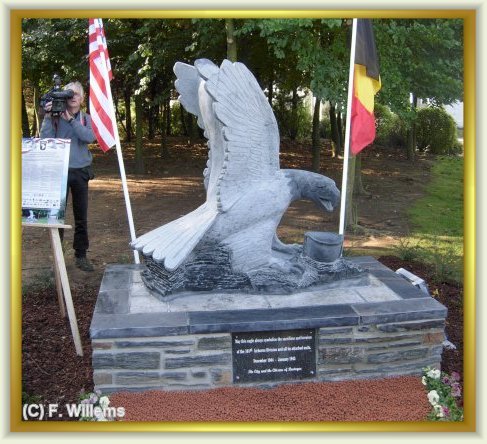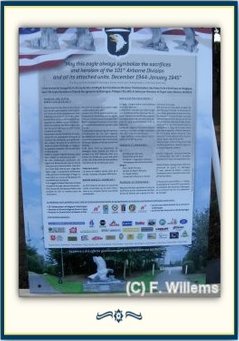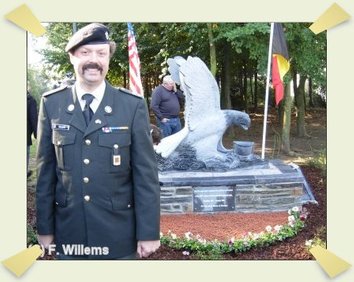Bastogne and the Battle of the Bulge
Mr. Doug BAILEY's "Bastogne" History
Woke up one morning at Mourmelon Le Grand and got the word that we were moving out and at that time I did not know where we were going.
This is my story I wrote for my Kids years ago about Bastogne, and also on demand of Col. Cooper:
About 10 years or so ago, Col. Cooper sent out letters to those of us that were at Bastogne to write and send him the memory's of our experience at Bastogne during that Battle. As my experience only lasted from the time we arrived in the area around December 19th until the 24th when I was wounded, and until around the 27th when the Ambulances got there and took the wounded out.
To: John T. Cooper
Dear John;
In your last letter to the troops, you asked us to tell what we did during the German tank attack on Christmas day.
My story must start on the 24th of December. I had Just moved back to the 4th gun section after spending all night standing in a foxhole on a snow covered slope out in front of B Battery's Gun position. When we went out to dig our defense line, Captain Cole passed out the last of the rifle ammunition and Grenades, We knew we were surrounded by the German Panzer, Parachute and Infantry divisions. We also knew about the surrender note and demand, so we knew we had to hold the position . During a fire mission later that morning a shell exploded right in front of the gun position, and for some reason there were only three of us on the gun at that time. Don Zafke, Cecil Farmer, and myself, and all three of us were wounded.
Tom (Doc) Pace our Medic came running across the snow and gave us some help, and patched us up as best he could , and then a Jeep came over to us , and they threw us in the Jeep and took us to the Church in Hemroulle that they were using as a aid station. The wounded were put along the wall. The Americans on one side and the wounded Germans on the other. This was only about 150 yards from where we were wounded. They used the equipment bundles and parachutes that came from the re-supply drop on the 23rd December to cover us.
The re-supply drop came just in the nick of time, as our squad had about 5 rounds of HE (High Explosive), about 6 rounds of AP (Armored piercing), and about 3 rounds of WP (White Phosphorus).
The concussion from the exploding shell made my legs numb, and I felt no pain. After lying on the floor for about a half hour, I started to get feeling again in my legs and I started to hurt. They had bandaged up my left leg where the shrapnel went in.
My right foot started to really hurt. I worked my hand down to my boot, and I could feel that it was all clammy. I called one of the medics over and they found that I had been hit in the right foot also.
Christmas day during the battle, All we could do was lie there and wonder what was going on. Shell fire broke the windows above us and the glass fell down an us, and one or two shells came through the roof exploding in the Church and re-wounding some already wounded Germans.
At one time during he battle, we could hear a tank running outside the church. When someone opened the door, I raised up, took a look and saw a German tank. I thought we had bought the farm. It turned out that it was one of the ones we had knocked out, and Booger Childress got it running and drove it into our lines. Heard later that they used it for a road block.
I don't know how long we laid in the church in Hemroulle before they roved us to the aid station in Bastogne. There wasn't anything they could do for us there. because the Surgical teams that were following the Division to Bastogne were cut off and captured. Also the room that had the whole blood plasma was hit by a shell that wiped it all out.
A building next door to the one we were in was hit by bomb's and caught fire killing most of the wounded and a Belgium nurse that was helping out. The wounded coming in with critical wounds, like stomach wounds, were just put over by the wall. There was nothing that could be done for them.
There was still quite a bit of shellfire hitting the town, but after surviving the Sicily Jump, Casino front, Anzio, and the Jump into Southern France, and the French Alps, I thought I was Invincible, Indestructible, and Immortal. At one time after a bout of shelling, I noticed the Chaplain going down the long line of wounded lying on the straw covered floor giving everyone the last rites.
When he came to me, he asked if I wanted them administered to me? I told him I wasn't Catholic. (I thought only Catholics did this.) Anyway, he gave me the last rites and moved on to the next man.
At that time things were looking pretty grim. The only thing I remember having to eat all this time was some English Taffy that was put in some of the re-supply bundles that were packed in England. I also heard about this time that James Ragsdale, who had been in my gun squad, had been wounded and then killed when the ambulances taking the wounded to the rear were ambushed and shot up.
When the 4th Armored Division broke open a road to us, the ambulances were loaded, and we were off over ice and snow covered roads through the Ardennes to a Evacuation Hospital in Thionville, France. Here they operated on me and took the shrapnel out of legs. I was here a few days and then we were taken out to an airfield where they more to fly us to Paris. This was a new tent holding area run by a Chemical Warfare Battalion. They were over there with all their nasty gasses in case the Germans used Gas on us. Since the Germans were not using Poison Gas, they had this outfit running this tent city taking care of helping, and transporting the wounded coming out of the Bulge fight.
I read somewhere that this was the coldest winter In Europe in 40 years. I believe it. We laid in those freezing tents on stretchers about 4 days. Didn't know which would come first. Would we freeze to death or starve to death first? This area was near an Airfield and since the weather was too bad to fly us out, they finally loaded us in ambulances again and took up to a railway where we were loaded on a Hospital Train.
We finally arrived in Paris where we were unloaded and carried to waiting ambulances by German Prisoners of war. I had a tag around my neck that had CZ on it. This meant that I was to go to a Hospital in the Paris area. CZ stood for Communications Zone . The Hospitals were full, so they changed the tag to UK which stood for United Kingdom, so now I was to be flown to England. They loaded us up on a C-47 that was rigged up with stretchers. I was put in a top stretcher up where the roof curved over.
I felt like I was in a coffin with the lid half closed. They flew us to Southern England, and I ended up in the 106th General Hospital near Bournemouth. They operated on me again in England, and then it was just a matter of letting time and good care do the healing. We had pretty Nurses, good chow, clean sheets, music in the ward, and even a movie once in a while. Another time I was taken by wheel chair to a U S 0 show at the Hospital. While I was putting up with all this, the Battalion was still in Belgium enjoying winter sports! Ha!!!!.
Finally I was released from the Hospital and sent to a replacement center near Birmingham, then to Southampton, over to Le Havre, and then to another replacement center up near the Belgium Border. At this time there was no guarantee that I, or anyone else would be sent back to their original outfit, they would just ship you to the Airborne unit that needed replacement the most. Needless to say this did not go over too well and the guys were just taking off from the center as soon as they found out where their original outfit was. I was about to do this, except I had heard the Battalion had left Belgium and was somewhere in Luxemburg. A few days later I heard that they had moved back to France, and about that time they changed the policy at the center , and so you knew you would be sent back to your own outfit.
I rejoined the Battalion at Mourmelon La Grande about a week before we loaded up and moved into Germany up on the Rhine River by Dusseldorf. We then headed south and were down by Munich when the war ended, and our long trek was over.
EPILOG
Colonel John T. Cooper:
Became Battalion commander after Colonel Hugh Neal was badly wounded shortly after we broke out of the Anzio Beachhead. After the war Colonel Cooper went back to practicing law.
Colonel Hugh Neal:
Became Battalion commander an the Island of Sicily, after we lost Colonel Harrison Hardin. After the war went back to building Bridges as a Engineer. Was from Baton Rouge, LA.
Captain Ardell Cole:
Became Battery commander of B Battery after Captain Harris was killed on the Anzio Beachhead. After the war became a Judge, an now retired, he lives in Paris, Tennessee.
Captain John S. Moore. (Battalion Medical Officer)
The Doctor that did such wonderful work on the wounded through all the battles. After the war went back to private practice in Albuquerque New Mexico.
Tom (DOC) Pace:
Was not really a doctor, but one of the two medics assigned to B Battery , everyone called him Doc. The other original medic was killed in the first few minutes of the Sicily Invasion. After the war Pace moved from Nebraska to Oregon where he worked in heavy construction. Now retired he lives in The Dalles, Oregon.
Cecil Farmer:
Badly wounded at Bastogne spent about 9 months in Hospitals in England and in the United States. After Discharged, worked for the Government in El Paso, Texas.
Donald Zafke:
also wounded at Bastogne, Went to Hospital in England. After discharge from Hospital rejoined the Battalion in France. After the War worked as a Architect for the State of Minnesota. He lived in White Bear Lake, Mn.
Booger Childress:
Not his real name, but everyone called him Booger. Was the one who put his undershirt over the barrel of the gun of the knocked out tank and got it running and drove into our lines. He was from Cowpens, South Carolina.
Doug Bailey
Was also wounded at Bastogne, went to Hospital in England. After discharged from Hospital, rejoined the Battalion in France. How retired and living in Port Angeles, Washington.
FROM THE TRADING POST MAGAZINE
Battle of the Bulge
Late in the day on 17 December 1944, the 463rd was placed on alert as a result of the German breakthrough in the Ardennes. In mid-afternoon on the following day, the artillerymen departed by truck from Mourmelon, France and headed north. As they neared Bastogne the roads became crowded with retreating soldiers from units that had received the brunt of the German onslaught.
On the morning of 19 December, after an all night drive, the 463rd arrived at the temporary headquarters of the 101st Division Artillery on the road south of Bastogne only to learn that no plans had been made for positioning the battalion. On his own initiative, the 463rd Battalion Commander elected to continue on to the Town of Hemroulle, about 1.5 miles northwest of Bastogne. The unit closed into this area at about 1500 hours and set up its Command Post and Fire Direction Center in the town. On the following day - 20 December 1944 - the Germans cut the remaining road leading into Bastogne and completed their encirclement.
The 463rd was assigned the mission of providing artillery support to the 327th Glider Infantry Regiment whose sector thinly covered the west and south borders of the defensive perimeter. Initially, this support was limited because of extremely heavy fog and low clouds which prevented the Forward Observers from adjusting indirect fire. However, fire missions were conducted whenever targets could be. On the 21st, the Battalion commenced redeployment of howitzers into previously prepared direct fire positions from which they could defend against tanks. This was done because of the changing tactical situation and also because supplies of high explosive ammunition had dwindled to the point where they insufficient to support heavy indirect fire missions. Fortunately, the 463rd had some armor piercing ammunition which it had obtained in Italy. This ammunition had not been listed on unit ammunition reports, and it was soon to become very useful.
About noon on 23 December, the weather allowed the first aerial resupply drop flown by 241 C-47 aircraft. It arrived none too soon. Some guns had no high explosive shells left, and others had only a half dozen or so. Rations were totally exhausted. The sight of the colored supply chutes coming down gladdened the hearts of the paratroopers. At dusk on the 23rd, the Germans launched an attack from the south in an attempt to break through the 327th Glider Infantry lines, but this was halted by midnight with heavy losses to the attackers.
In the pre-dawn hours of 25 December - Christmas Day - the Germans launched a second all-out attack intended to wipe out the Bastogne pocket. This time it was out of the northwest and headed straight toward the 463rd. Eighteen Mk. IV tanks with supporting infantry broke through the thin defensive line of the 327th Glider Infantry and began to advance toward Hemroulle. After the initial breakthrough, little opposition was met, and the German tank infantry team with eleven of the tanks proceeded several miles to the outskirts of Hemroulle. Evidently mistaking the town for Bastogne, the tanks and infantry pulled off the road and halted. Their stopping point was only about 100 yards from several of the 463rd howitzers which were virtually invisible because of the darkness combined with a recent light snowfall. Incredibly, the German column remained in this position for over an hour. The battalion headquarters had been alerted to the presence of the tanks by an outpost guard, however, Major Cooper ordered that fire be withheld for as long as possible. This was done in hopes that the light of dawn would improve the hit probability and because of a concern that the tanks might, after all, be American. As the dawn broke, the outline of the German tanks and their distinctive muzzlebrakes made identification unmistakable. When the command to fire was given, the ensuing battle lasted approximately half an hour, and during this time many of the 463rd men fought as infantry. Eight tanks were knocked out by the howitzer crews and when one of the others received a hit which injured its commander, it was captured intact by an artilleryman who hung his undershirt on the tank's muzzlebrake and drove it back to within the battalion's defensive perimeter. Two tanks managed to escape the deadly fire of the 463rd but were destroyed by a rapid deployment armored force dispatched by Division Headquarters. Of the eighteen tanks which began the assault, none survived the day.
In the gathering darkness just after 1700 hours on the following day - 26 December - the first elements of Combat Command R of the 4th Armored Division broke through the German encirclement from the south and relieved the siege. During the period 19 December to 31 December 1944, the 463rd fired over a 360 degree sector, expending a total of 7,676 rounds of ammunition on almost every kind of ground target.
Troopers Richetto, Tower, and Kummerer in a 1945 photo.
Note the Italian jump wings being worn on the left side of the Ike jackets.
When asked why these wings were worn,
Bud Tower replied "to impress the girls, what else"
The victim of anti-aircraft fire, this C-47 crashed in front
of the 463rd positions at Bastogne.
Before it touched down, its tailwheel is said to have
caught a 2 1/2 ton truck and spun it around.
The driver of the truck emerged at a full run.
Bastogne villages and roads today
A Condensed Chronology, by Martin GRAHAM
Based in large part on a collection of archival documents and other materials,
acquired and provided by Ken Hesler, Battery D, 463rd PFA.
December 1944
December 12 | Tuesday
The 463rd arrived in Mourmelon, France at 2:30PM by train.
They were temporarily attached to the 101st Airborne Division for administration and rations.
Battalion Officers:
Commander: Lt. Col. John T. Cooper, Jr.
Executive Officer/S-1: Major Stuart Seaton
S-3: Major Victor E. Garrett
S-4: Capt. John F. Keester
Surgeon: John S. Moore
Battery A: Capt. William H. Gerhold
Battery B: Capt. Ardell E. Cole
Battery C: Capt. Roman W. Maire
Battery D: Victor J. Tofany
Officers Warrant Off. Enlisted
Hq & Hq Btry 19 1 168
A Btry 5 92
B Btry 4 89
C Btry 5 97
D Btry 5 93
Med Det 2 14
TOTAL 40 1 553
2 enlisted men returned from hospital and 2 from confinement.
Took about 1,500 rounds of ammunition.
December 16 | Saturday
GENERAL SITUATION
0500 Heavy German artillery begins fire along Ardennes front
0800 German infantry and armor attack begins
December 17 | Sunday
GENERAL SITUATION
OB WEST - Field Marshal Gerd von Rundstedt
Army Group B - Field Marshal Walter Model
5th Panzer Army - General der Panzertruppen Hasso-Eccard von Manteuffel
47 Panzer Corps - Lt. Gen. Heinrich von Luttwitz
Panzer Lehr Division - Lt. Gen. Fritz Hermann Bayerlein
901st Panzer Grenadier Regiment
902nd Panzer Grenadier Regiment
26th Volksgrenadier Division - Maj. Gen. Heinz Kokott
39th Fusilier Regiment
77th Volksgrenadier Regiment
78th Volksgrenadier Regiment
2nd Panzer Division - Col. Meinhard von Lauchert
304th Panzer Grenadier Regiment
5th Parachute Division
General McAuliffe called a meeting of all officers in camp at 2100 hours, informing them about the German breakthrough in the Ardennes and informed officers that the 101st division was to prepare during the next two days to pull out to confront the enemy somewhere near Bastogne.
After the meeting, Col. Cooper met with McAuliffe to offer the 463rd's services. McAuliffe asked, 'How soon can you move out with the 101st?'
Since the battalion had not yet unloaded their trucks since their arrival at Camp Mourmelon, Cooper replied, '45 minutes - but I don't have any orders'
(the 463rd was slated to join the 17th Airborne Division which had not yet arrived from England).
'To hell with that,' McAuliffe said, 'to see Bud Harper of the 327th.'
Cooper found Harper, who had just returned from England and was still in dress uniform.
'Do you need me?,' Cooper asked, to which Harper replied, 'Your Goddamn Right.'
Cooper went back to his officers and gave them a choice, either join the 101st in its drive to Belgium or remain behind as camp guards.
To a man, the officers voted to go.
December 18 | Truck | Monday | Suippes, France
GENERAL SITUATION
380 vehicles began moving the 805 officers and 11,035 enlisted men of the 101st at 0900 for the 8 hour ride to Werbomont, Belgium where they were to form a defensive line. The unit commanders were ordered to pull out in combat teams without waiting for the men on pass. McAuliffe rode in advance.
The 101st was composed of:
Acting Division Commander: Brig. Gen. Anthony C. McAuliffe
G-1 and Acting Chief of Staff: Lt. Col. Ned D. Moore
G-2:Lt. Col. Paul A. Danahy
G-3:Lt. Col. H. W. O. Kinnard
G-4:Lt. Col. Carl W. Kohls
Surgeon: Lt. Col. David Gold
Div. Artillery Commander: Col. Thomas L. Sherburne, Jr.
501st Parachute Infantry Regiment: Lt. Col. Julian J. Ewell
502nd Parachute Infantry Regiment: Lt. Col. Steve A. Chappuis
506th Parachute Infantry Regiment: Col. Robert F. Sink
327th Glider Infantry Regiment: Col. Joseph H. Harper
Executive: Lt. Col. Thomas J. Rouzie
1st Battalion (Companies A, B, C, & Hqs): Lt. Col. Hartford F. Salee
2nd Battalion (Companies E, F, G, & Hqs): Lt. Col. Roy L. Inman
Maj. R. B. Galbreaith following Inman wounding
3rd Battalion (Companies A, B, C, & Hqs)
AKA 1st Battalion, 401st GIR: Lt. Col. Ray C. Allen
321st Glider Field Artillery Battalion: Lt. Col. Edward L. Carmichael
907th Glider Field Artillery Battalion: Lt. Col. Clarence F. Nelson
377th Parachute Field Artillery Battalion: Lt. Col. Harry W. Elkins
463rd Parachute Field Artillery Battalion: Lt. Col. John T. Cooper, Jr.
81st Airborne Antiaircraft Battalion: Lt. Col. X. B. Cox, Jr.
326th Airborne Engineer Battalion: Lt. Col. Hugh A. Mozley
426th Airborne Quartermaster Company: Capt. George W. Horn
101st Airborne Signal Company: Capt. William J. Johnson
801st Airborne Ordnance Maintenance Company: Capt. John L. Patterson
326th Airborne Medical Company: Maj. William E. Barfield
At the crossroads to Bastogne, McAuliffe headed toward that town, which was the VIII Corps headquarters of Maj. Gen. Troy H. Middleton to gather more information on the German breakthrough.
McAuliffe learned that his division had been attached to the VIII Corps and that he was under Middleton. Middleton informed McAuliffe that he was moving his headquarters to Neufchateau, 18 miles southwest of Bastogne.
The 101st was ordered to take over the defense of Bastogne, a vital communication center with 7 roads radiating from the central square (including the main east-west highway running from the German border to Dinant and the Meuse River, vital routes in Hitler's thrust toward Antwerp).
It's population was over 4,000 and it stands on a plateau at 1,600 feet elevation.
The plateau lacks the vast expanses of forest and the turbulent terrain of most of the Ardennes; much of it open pastureland amid rolling hills with occasional wood lots of coniferous trees. The town has no natural defense features other than the surrounding hills, but concentric circles of farm villages with sturdy brick and stone buildings providing solid anchors for defensive positions.
McAuliffe chose Mande-St-Etienne, 4 miles west of town, as the division staging area. Middleton had sent units from Combat Command B, Col. William L. Roberts, to block the German advance on the town.
THE FOLLOWING DISPOSITIONS WERE MADE:
Task Force O'Hara (Lt. Col. James O'Hara)
500 men/30 tanks to block road from southeast from Wiltz near Wardin
Task Force Cherry (Lt. Col. Henry T. Cherry)
block road from Longvilly (in path of Panzer Lehr Division).
Task Force Desobry (Maj. William R. Desobry)
15 tanks/platoon of tank destroyers/company of armored infantry to hold
the town of Noville which was in the path of the German 2nd Panzer Division.
GERMAN PLAN OF ATTACK:
Panzer Lehr to advance from Mageret toward Bastogne with 2 regiments of the 26th Volksgrenadier Division making a right wheel to circle through Longvilly and Luzery to enter Bastogne from the north via the Noville Road.
2nd Panzer Division to bypass Bastogne and race to Meuse River.
The action of the day centered around Noville where the Germans lost 19 tanks. The German attacks over the next few days would be hampered and slowed by mud which would bog down tanks and supply trains.
Joe Lyons:
Then, like a thunderclap, came the order: "Get them men out of the brothels and bars", "Drag the officers from the land of no return" -- the officers club, "It's time to earn your keep". Then started the retrieving of the lost souls.
Don Martin:
Being a Pack Howitzer unit and going long distances we either went by air, truck or mule. This time it was by truck. This truck unit being called the 40 & 8, driven by black soldiers. We loaded everything we could with the small number of vehicles we were allowed. We did have some trucks which made up our supply unit. They were to come later with more ammunition, food, etc. We traveled all night, then about mid-morn the next day we began encountering troops coming from the opposite direction. This wasn't good as far as I was concerned. These troops were from the 42nd, 106th Divisions and their supporting troops. Then we found another group intermingled with these troops and they were Germans that were dressed as American soldiers, they caused us a lot of trouble. The further we went the more traffic, roads becoming blocked, etc. I talked to some of these soldiers and they gave me some account of what had happened.... I was the liaison officer between the 327th GIR and the 463rd. I kept my battalion informed of intelligence concerning the enemy, weather, terrain, planned fires to support the mission given the 327th, place other liaison officer, forward observers and fire missions of my own.
Vic Tofany:
I was in the lead truck of D Battery and was following B Battery in the convoy. Lt. Kranyak was leading the column. He missed the turn-off and we had to turn around. When I asked him what went wrong, he said he was following D Battery. We turned around by winding the trucks out into a field and then winding them back onto the road. When we had them all turned around, the last truck had his front wheels in the ditch next to the road. The black driver said he couldn't get out because his front wheel drive wouldn't work. I think he was stalling. Lt. Eastman jumped into the drive's seat and promptly backed it out onto the road. We were told when we left we could leave our lights on until we got to Werbomont. However, when we stopped about 10 miles short of Bastogne, I was cooking coffee on the hood of the jeep (I decided to do my own leading of the column) and a tank came by headed to the rear and told us to "put out that goddam light!" I talked to him and he said things were changing very rapidly. About 5 more miles and we caught up to the rest of the 101st. At dawn we were bumper to bumper outside of Bastogne. Thank God for the fog.
Ken Hesler:
I was one of several riding in the back of a covered 2 1/2-ton truck filled mostly with 5-gallon cans of gasoline and pulling a trailer. It was cold and damp, and I slept as best I could using both the seat and the tops of the gasoline cans for support. We were lost briefly at least once during the night. After dawn, we took advantage of the stops to heat instant coffee over stoves made of a C-ration can, dirt and gasoline. I recall, with no great pride looking back on history, how we shouted to small groups of tired soldiers from the 28th Division trudging along the other way to remind them that "Hey, you're going the wrong way. The Germans are this way."
We saw little, if any, of the confusion. Coming in from the west, we did not go into Bastogne, stopping first south of Flamizoulle. We dug in along the road, and a few hours later moved on to Hemroulle.
Dec. 18 | Truck | Mazagran, France
Dec. 18 | Truck | Vouziers, France
Dec. 18 | Truck | Sedan, France
Dec. 19 | Truck | Bouillon, Belgium
Dec. 19 | Truck | Marche, Belgium
Dec. 19 | Truck | 1 KM SW Flamisoul, Belgium
Arrived 9AM
December 19 | Tuesday | Bastogne, Belgium
Situation map of December 19th.
(Click to show the entire map)
GENERAL SITUATION
At 0500 only advance guard of Panzer Lehr pressed toward Bastogne. The Germans occupied Margaret at about 0030 and later took Neffe. The German plan of attack called for the Panzer Lehr to advance toward Bastogne with 2 regiments of the 26th Volksgrenadier Division making a right wheel to circle through Longvilly and Luzery to enter Bastogne from the north via the Noville Road. But infantry was exhausted with supply trains far to the rear.
501st first encountered Bayerlein's force outside of Neffe at 0900. There was very little communication between Combat Command B and the 101st. They acted as independent units until Combat Command B was placed under Gen. McAuliffe. Ewell (501st PI) positioned 1st Battalion in front of Neffe, 2nd Battalion took Bizory but stalled at Hill 510, and 3rd Battalion to Mont and ridge south of Neffe. While 3rd Battalion failed to get around Neffe, Company I engaged in bloody close range fire in Wardin which fell to Germans.
Team Cherry advance guard encountered tanks at 1000 southeast of Longvilly. They fell back to a position southeast of Mageret at 1430. American artillery hit German positions along Ewell's front. Heavy fog hindered German advance.
By evening, American troops east of Mageret were in varying stages of tactical dissolution. German tanks hit Desobry's roadblocks north and east of Noville at 0600. At 0730, Desobry pulled troops into Noville.
By 1000, Desobry faced more than 42 German tanks. Of 14 German tanks trying to flank Desobry to the North, 10 picked off. German's shelled Noville. Team Desobry reinforced by 1st Battalion, Lt. Col. James L. LaPrade of the 506th Regiment, Col. Robert F. Sink. American counterattack only able to advance 500 yards. German shell killed LaPrade and seriously wounded Desobry.
The division hospital near Bois de Herbaimont west of Bastogne had been overrun by the enemy. The Germans, when they arrived at the Division hospital, started shooting it up. The doctors told them it was a hospital and were allowed 30 minutes to load the wounded. The division surgeon and surgical team and all surgical supplies were taken.
Reports that wounded were placed on the front of vehicles to protect against a fight.
463rd SITUATION
ROUTE OF THE 463RD:
Bouillon, Belgium
Marche, Belgium
Bois de Herbaimont, Belgium
1 KM SW Flamizoulle, Belgium (arrived 9AM)
Bastogne, Belgium (arrived 11AM)
Hemroulle, Belgium (arrived 3PM)
463rd arrived at 1500 hours and set up its Command Post and Fire Direction Center set up in a house with the Aid Station in a chapel across the street. Mission was to provide artillery support to the 327th Glider Infantry west and south of Bastogne.
Battery Positions:
- C: 500 yards slightly to the northeast of Hemroulle
- A: 350 yards southwest of Hemroulle on right side of road leading to Bastogne
- D: 750 yards southwest of Hemroulle on left of road
- B: a few yards beyond Battery D on the right of the road
ACTION
5:00PM, A Battery fired 9 rounds of WP and 2 rounds of HE for registration.
5:25PM, D Battery fired 5 rounds of WP for registration.
The weather continued to be cold, cloudy and foggy with poor visibility. After crossing the Meuse, the truck convoy, with frequent stops and delays, entered Belgium. Near the Bois de Herbaimont, where the northward route intersects the Namur-Bastogne road, the 463rd found Col. Sherburne, the acting 101st artillery commander, directing traffic and sending the convoy southeast towards Bastogne. Dawn was gray, dreary, cold and wet. During the many frequent stops, troops would jump off the trucks, pour gasoline into puddles along the roadway and try to warm themselves or heat canteen cups of water for coffee over flaming C-ration cans partially filled with gasoline-soaked gravel. Along the way, the convoy passed groups of infantry, mostly from the 28th Division, walking single-filed along the roadway away from Bastogne. Occasionally, someone from the battalion would shout to them, "Hey, you fellas are going the wrong way."
At 9AM the trucks turned north off the highway to an assembly area about 1KM southwest of Flamisoul where they dug foxholes along the roadway and waited. Finally they were directed to proceed to Bastogne, where they arrived at 11AM. The battalion reached Bastogne without any maps since they had been originally ordered to Werbomont. When they arrived, Col Cooper went to the collection point which also proved to be division artillery headquarters and asked where he should place his men. He was told that they had no equipment, no wire, no phones, and no information. He looked at their map and decided to move to Hemroulle, 1.5 miles northwest of Bastogne, the sector assigned to the 327th, since the battery's mission was to provide artillery support to that unit west and south of Bastogne. The 463rd communication section tied a telephone line around a tree, and laid lines to Hemroulle and later to all the artillery battalions. After arriving in the village at 3PM, the Command Post and Fire Direction Center were located in a house in Hemroulle, with the Aid Station in a chapel across the street.
APPROXIMATE DISTANCES FROM BATTERY POSITIONS SOUTH OF HEMROULLE:
Rolle(y) - 2,000 yards Marvie -6,000 yards
Champs - 3,000 yards Remoifosse - 7,000yards
Longchamps - 4,000 yards Assenois -7,000 yards
Recogne - 5,000 yards Senonchamps- 4,000 yards
Noville - 7,500 yards Mande St.Etienne - 3,500 yards
Bizory - 6,000 yards Flamisoul - 4,500 yards
Mageret - 7,000 yards Flamierge -7,000 yards
Neffe - 6,000 yards
December 20 | Wednesday
Situation map of December 20th.
(Click to show the entire map)
Hemroulle with
chapel (aid station)
and CP (buildings left)
GENERAL SITUATION
The weather continued to be cold, cloudy with heavy ground mist. The mist lifted somewhat by 10AM, but by midnight, as a strange silence surrounded Bastogne, the fog thickened. Temperatures dropped below freezing and the first snow fell.
Germans attacked the 1st Battalion, 506th PIR and Team Desobry at Noville at 0530. American's destroyed 2 German tanks attacking Noville. At noon, Americans ordered to fall back from Noville to Foy, defended by the rest of 506th, which had been lost earlier in the day and taken again at 1400. The Americans from Noville were safe behind the lines at Foy by 1700.
At 1125, the 901st Panzer Grenadier Regiment, 4 tanks and 6 halftracks, attacked Team O'Hara and the 2nd Battalion of the 327th GIR at Marvie. After fierce fighting, Americans held Marvie.
At 0730, the 2nd Battalion of the 78th Grenadier Regiment attacked the 501st PIR near Bizory backed by 8 tanks and a pair of self-propelled guns. American artillery hammered position for 20 minutes.
At 1900 the 902 Panzer Grenadier Regiment attacked the 501st along the road from Neffe into Bastogne following heavy artillery fire. American artillery hammered the attacking force. At dusk, one company of the 501st exchanged fire with two companies of Germans advancing west along the railroad at Halt.
The road to Neufchateau was cut during the evening and Bastogne was isolated. The 463rd supply train, sent back for more ammunition, was cut off.
Col. Ray C. Allen of the 3rd Battalion of the 327th GIR sent B Company under Capt. Robert J. MacDonald to destroy the barrier near Bois de Herbaimont at the Sprimont-Bertogne intersection. They killed 50 Germans and scattered the rest. They found the ruins of the 101st Hospital. They found 2 bodies of paratroopers with slashed throats.
101ST DEFENSE OF BASTOGNE CONSISTED OF:
The 502nd held the northern sector of the American line in the Longchamps and Sonne-Fontaine area.
Northeast of Bastogne, the 506th was deployed with one foot in Foy and the other next to the Bourcy-Bastogne rail line.
To the right of the 506th, the 501st faced east - one flank at the rail line and the other south of Neffe.
The 2nd Battalion, 327th, held the Marvie position with an open flank abutting on the Bastogne-Arlon highway. The 1st Battalion of the 327th GIR was south of Bastogne with the 326th Engineer Battalion strung thinly across the Neufchateau Road and onto the west. The division trains and service companies were directly west of Bastogne.
Defense fell on the 420th Armored Field Artillery Battalion (Task Force Browne).
The 3rd Battalion 327th GIR held the line from the Marche-Bastogne Highway to Champs.
463rd SITUATION
ACTION
3 Baker - Lt. William D. Anderson in vicinity of Neffe
6 Baker - Lt. Jack C. West in Neffe area in AM, Foy in PM
5 Able - Lt. A. Martin in vicinity of Neffe
Personnel
Most of the firing during the day was into the area between Bizory and Neffe,
with other fire missions to the northeast around Noville and Foy, Mageret
and to the southeast in the vicinity of Marvie.
Casualties
Pvt. Charles R. Davault, Hq Btry, slightly WIA by shell fire
Pvt. William L. Hurley, D Btry, slightly WIA by gunshot
Pvt. James G. Ragsdale, B Btry, seriously WIA by shell fire, killed while being transported to the rear.
The 463rd Supply Train sent back for more ammunition was cut off. The 463rd was assigned the mission of providing artillery support to the 327th GIR whose sector thinly covered the west and south borders of the defensive perimeter. Initially, this support was limited because of extremely heavy fog and low clouds which prevented the Forward Observers from adjusting indirect fire. However, fire missions were conducted whenever targets could be spotted.
Gordon Bernhardt
Slept all night, but the crew on duty did a bit of firing. Our infantry is having it rough, but we're holding. We can't get any ammunition through, we had 18 trucks wiped out. We are digging defensive positions all over area, fox holes everywhere, ready for the last stand, on guns in night.
Tom White
I was a Captain assigned to the 506th PI as Liaison Officer. A few days after we were relieved of combat duty and were recuperating in Reims, France I was ordered to report to Gen. Maxwell Taylor immediately. I had been his aide through Africa, Sicily, Italy, and Normandy. Because of this long past association he offered to take me back to the states for approximately two weeks to brief the Pentagon on airborne operations. We left the same day, December 20??, and flew back to Washington via Prestwick, Scotland; Gander, Newfoundland and on to Washington.
Don Martin
The Medical Battalion had occupied a position about due north of the 463rd's position. I had been on reconnaissance in this area as they were going into position. The next morning I was back in that area as we were to put an infantry battalion in that area, the Germans were making their circle around us. But there was no medical Battalion there. Except for the personnel that escaped they had been demolished.... The weather was real foggy, sometimes you couldn't see 30 to 40 yards in front of you. The air force had no visibility so we could get no support from them, which we relied on very heavily. Now this put us in a position of firing artillery only when we just had to. Therefore we could not give the infantry the support they needed and were used to. The word of course had by now reached all the front line soldiers and as a result two things were revealed. The first Esprit de Corps and self preservation.... First we had what we called the "Midnight Charlie" or a German plane that came over every night and bombed us. As a result of this, even though I was not in the front lines I took precautions. The 327th was headquartered in an old army barracks, which were one story, tile roof and had thin tile floor inside. I decided I better not get caught short, because that bomb came straight down from that airplane. I decided I would dig through that floor with a wall locker on top of it with dirt in the locker and deep enough to be comfortable in, this I did. Mind every one knew this was my hole, some made fun of me but I didn't care because I knew how much a hole in the ground could protect you. Well about the third night when Charlie decided to drop a bomb right on top of our building. My hole was filled with those persons that had made fun of me for digging it. When the bomb hit the whole ceiling fell in. Charlie departed I got out of my hole, the part that was in it, checking my condition, my jacket I had on was riddled with shrapnel and plaster from the ceiling. I just knew I had been hit, I wasn't, none had penetrated the lining of my jacket. Oh! I was mad and I can assure you no one got in that hole after that unless they had my permission. I decided I would go across the street a short way from where I was and check to see how many prisoners we had taken and any information I could pick up from them. When I got over there there was only 2 or 3. For some reason our front line troops just wasn't taking prisoners. I understood. From there I decided to check the hospital we had set up. I sure didn't tarry long there. The doctors had no way of putting people to sleep and they were having to operate, amputate, etc. by just holding the man down. It seemed inhumane, but was very necessary. I think this was the saddest experience I had in Bastogne. Later that day, Col. Harper had to go down on the south front to check on some things, while down there the Regimental Exec. was there and had found a country ham at a farmer's house. Me being from Mississippi and a farm boy, we cured our meat, so I could just taste that ham. That old codger was so stingy with that ham he wouldn't even give me a slice of it. How disappointed can you be? We returned to Hdqts when we finished what we had come to do there. That night Charlie visited us again. Now when he came tonight, Col. Harper, Major Jones, and myself were in Col. Harper's room planning fires and discussing the situation. There was a double bunk bed in this room so when we heard the bombs landing we all three dived for under those beds. Well this was a roll around each of the three of us trying awful hard to be on the bottom for more protection. When it was over we crawled out and just stood looking at one another, shaking our heads.
December 21 | Thursday
Situation map of December 21st.
(Click to show the entire map)
AMERICAN SITUATION
Temperatures fell dramatically in the morning, causing the heavy mist and fog to roll about like steam. It cleared somewhat in the afternoon; but in the early night, clouds moving southwest brought more snow. Later, it was clear and cold. It was the first day of winter.
In the foggy morning light, Capt. MacDonald's men (327th GIR/B) were attacked by seven 75mm guns, 9 half-tracks and 7 light vehicles. The German column was destroyed. Later that afternoon, MacDonald was ordered to fall back to the battalion.
The Germans planned to send the 77th and 78th Grenadier Regiments along the Bourcy-Bastogne rail line, in the gap between the 506th and 501st PIR's. At 0830, a 506th patrol discovered Germans in the woods behind their right flank. After 3 hours of fighting between the Germans and men of the 506th and 501st, the Germans were repelled.
During the afternoon, the 902nd Panzer Grenadier Regiment attacked the 3rd Battalion 501st PIR at Neffe.
The Kampfgruppe Kunkel pressed north through Villeroux, driving the American defenders back toward Senonchamps. American artillery successfully drove the enemy back.
463rd SITUATION
ACTION
3 Baker - Lt. Anderson & Lt. Harold Hodge in Neffe area
4 Baker - Lt. John W. Frye south of Bastogne in area of Bois d'Hazy
6 Baker - Lt. West north in vicinity of Foy and Recogne
AWARDS
1st Lt. Jack C. West, forward observation post 6 Baker,
was awarded Bronze Star for his achievements Dec. 19 to 21.
2 howitzers from Battery C redeployed about 700 yards northwest of Hemroulle astride road to Champs into direct fire positions from which to defend against tanks. Howitzers moved into direct fire positions due to ammunition shortages. The battalion began to redeploy howitzers into previously prepared direct fire positions from which they could defend against tanks. This was done because of the changing tactical situation and also because supplies of high explosive ammunition had dwindled to the point where they were insufficient to support heavy indirect fire missions.
1st Lt. Jack C. West, forward observation post 6 Baker, was awarded Bronze Star for his achievements Dec. 19 to 21.
Donald Martin:
I had to go out on the west front, on my way I had to pass our gun positions. I decided I had better get some new radio batteries as mine were getting weak. Now the radio section was set up out behind Battalion headquarters. While I was in getting the batteries I heard two of these black soldiers that had driven the trucks for us talking. One of them told the other one to do something, he said back to that one "Do it yourself you s-- -- - -----." The other said back, "Boy I ain't no s-- -- - -----." That one says back, "I'm a airborne troop." Now I recognized one of those voices. I went out to check, sure enough I knew one of them. It was a black boy from home, my age, use to go fishing with and worked on our farm. My point is "What a small world even in a place like Bastogne." From here I proceeded to go on to the front line. I got about as close as I figured safe with my jeep and hid it in some trees. Walking on to the top of the hill. My driver had gone with me. Just as we got to the crest of the hill a group of German soldiers were coming up the other side. We wouldn't have time to go back down without being seen. This area being heavily wooded with thick spruce trees and snow about a foot deep, we decided to crawl in next to the tree and get under the snow. There had been other footprints around so they might not notice ours. This we did Germans walked all around that tree and never did discover us. We were getting air from a hole next to the tree. You would be quite surprised how warm you can stay as long as no air hits you. We stayed there until dark, then got out and went back down the hill, expecting our jeep to be gone but they hadn't found it either. We lost no time getting back to Headquarters.
Gordon Bernhardt
Our guard had to dig in a new guard, but moved 100 yards away. Dug pit also on top of hill to fire direct, in case of last stand. We are surrounded, no firing, no ammunition, in case of last stand. Had a tent to sleep in, really slept all night.
Tony Spagnol
"We were bivouacked on a knoll at the edge of pine tree forest in front of a road leading to the west of our position with the 327 Infantry. At very early dawn, on December 21, 1944, a German recon outfit with about 8 vehicles, including half-tracks and jeeps came racing down the road to our front. The infantry held their fire until the recon outfit was directly to our front and then opened fire with machine guns, bazookas, grenades, rifles and everything we had. I took a few shots with my M-16. Every German in the recon outfit was killed in this action, the Germans didn't have a chance. I believe they were either on a recon mission or lost!"
December 22 | Friday
Situation map of December 22nd.
(Click to show the entire map)
AMERICAN SITUATION
Mists, clouds, and snow of the previous day had vanished for the moment as a nearly full moon set about midnight. A crust which crackled underfoot with each step had formed on the snow, 2 inches deep, from the cold; and by morning the snow came again in big flakes. Occasionally, the sun would reflect brightly off the frozen, white terrain before again being shut out by clouds. Snow and fog closed in again during the afternoon. 1 day supply of rations (220 K-rations & 400 10-1-rations) remained.
Shortage of ammunition was critical and restrictions were placed on fire missions. Gasoline supply down to one-half day. An air supply was planned for 2000 but was stopped due to poor flying weather. During the night, the Germans repositioned west of Bastogne. At daybreak, American riflemen entered woods outside of Senonchamps to drive away Germans. A detachment from the Kampfgruppe Kunkel at 1600 set out from Villeroux to strike the American right flank, but were driven back.
Three separate German assaults from the woods were driven back. About noon, 4 Germans with a white flag entered the lines of the 2nd Battalion 327th GIR. Their message called for the 'honorable surrender of the encircled town' within two hours or risk 'annihilation' by the massed fires of the German artillery. Word on the German demand for surrender spread throughout the battalion, and by evening a division communication had been sent around.
463rd SITUATION
ACTION
3 Baker - Lt. Anderson & Lt. Harold Hodge in Neffe area
4 Baker - Lt. John W. Frye south of Bastogne in area of Bois d'Hazy
6 Baker - Lt. West north in vicinity of Foy and Recogne
CASUALTIES
Cpl. Eugene M. Archer, C Btry, WIA
Lt. William Anderson, B Btry, MIA
T/4 Frank Pfeil, B Btry, MIA
Pvt. Herman Nelson (??), B Btry, MIA
Pvt. Oroland Maser, B Btry, MIA
1 day supply of rations (220 K-rations & 400 10-1-rations) remained. Shortage of ammunition was critical and restrictions were placed on fire missions. Gasoline supply down to one-half day. Remaining 2 guns from Battery C and 2 guns from Battery A were shifted into anti-tank positions around Hemroulle. After the enemy demand for surrender, the order went out for all barracks bags to be piled, ready to be burned. The cannoneers were oiling their rifles and carbines in case they were over-run by the enemy.
Gordon Bernhardt
Snowing all night. Slept all night long. Things are getting serious around here, stayed in fox holes around area, expecting a big attack but nothing happening except the usual attacks.
Stuart Seaton
I do recall vividly the day I took our battalion's plan for perimeter ground defense in to Division Artillery Headquarters. When I got there, the first thing I was greeted with was a comment by Col. Sherburne. He told me that Gen. McAuliffe had just received a surrender notice from the German commander. I believe he said it had been delivered by a German major. Col. Sherburne gave me a copy of it (which unfortunately I have lost). After reading it, it said that if the division didn't surrender by four o'clock they would level the town. I think it was then about two o'clock. After getting the plan checked, I wasted little time getting out of the city (Bastogne) and back to the battalion.
Bruce Middough:
That afternoon I was detached from C Battery to Headquarters Battery along with another C Battery soldier. We reported to the 1st Sgt. who sent us to a farmhouse on top of the ridge between Hemroulle and Bastogne. Hidden behind the farmhouse was a truck containing all the battalion gasoline supply. I dug a foxhole on the ridge and pulled the first 6 hour shift while the other man slept. At about midnight the Germans started to shell Hemroulle. The shells were just clearing the ridge and passed right over the top of my head and dropped into the village. After the shelling stopped I decided my 1.5' deep foxhole needed another foot or so of depth. When that was completed I now laid my blankets out, climbed in the hole and started to get some sleep. I was just dozing off when I heard the weird sound of a motor. It was a slow moving aircraft with a put, put, put sound. As there had been rumors of German paratroopers and not having ever heard the sound of a V-1 buzz bomb, I thought this was a troop transport dropping German paratroopers among us. I sat up in the hole, cocked my Tommy gun and waited. This was my most terrifying moment during the siege as there were no other soldiers near me. I sat there trying to see something but never did. So after about 20 or 30 minutes I laid down again on my back in the foxhole, pulled my blankets over me and went to sleep. A little while later I was again awakened by an odd tingling in my face. Again I sat up and discovered it was snowing.
Frank Pfeil
On the morning of Dec. 22, I was told to set up a radio back back and since we were not going to out too long, just take a couple of K rations to hold me over for the day for we were to go out to register our guns. There were 4 of us in the forward observation party. Lt. Anderson, Pvt. Nelson, and our jeep driver who I can only remember as being called Gopher (identified by Lark A. Erskine as Oroland Maser from Kentucky). He got that nickname while at Anzio because he always dug one of the deepest foxholes. We first went to Bn. or Div. HQ for instructions. I don't know which one it was but I believe it may have been Div. HQ for when Lt. Anderson came from the building with a map rolled up in his hand, he said the Germans just delivered an ultimatum for our troops surrender.... We continued through a town that may have been Bastogne or Hemroulle. We went through there quickly for it was being heavily shelled. The next event was when we were stopped by American troops at a cross road and challenged. We learned then they were on the alert for Germans posing as American GIs. We then continued on over open country and at the next point we were stopped by American soldiers at a farm house and were told there was a German machine gun emplacement ahead. Anderson asked them why they didn't use the tank destroyer next to the house to take care of the situation. He was told the crew did not want to expose themselves to possible anti-tank fire. Anderson decided to circle around the road block and try to use our Battery to bring fire on the German gun position. We took off in the jeep again and a short time later we received burp gun fire from a tree line and at the same time our jeep bogged down in deep snow. We then ran to a wooded area nearby. Anderson was first in line, I was second, Nelson third and Gopher last. I saw Anderson stop at a fire trail or break in the forest while using his binoculars to look up and down the clearing. He took several steps into the clearing when we heard "Halt." I had difficulty seeing what was happening because when we hit the ground the radio back pack went forward and pushed my helmet over my face and into the snow. Anderson was still standing and talking to someone. I was praying that it was our troops and not the enemy. I then heard Anderson say to us you might as well come out they've got us. When we did come forward I could see by the number of men in their patrol that he was so right. This story could go on and on, for the POW experience from the time of capture to our being liberated by the 47th Bn. 86 Div. is one I'll not forget.... The last time that I saw Anderson was in a field along side a road. He had a grapefruit size hole in his thigh caused by the strafing of our POW column by P47's while we were being marched by the Germans to the rear. Nelson and Gopher I last saw them at a POW camp XIII A in Koblenz. The three of us were being separated, since the Germans didn't want enlisted men together with the NCOs. Both men were in bad condition because their feet were black from the effects of frost bite. They were hoping to be returned to the US control by the Red Cross. As for me, fortunately, the day before going on patrol I changed into my winter combat suit and snow packs. The other three had not, so their physical conditions were not good.
Donald Martin
Col. Harper was called to come down to the Battalion on the South, same place where the Lt. Col. had the ham. I went with him. When we arrived there a German Major & Capt. had come to our front line with a white flag (PEACE). They wanted to talk to the commander of the American troops. We blindfolded them and took them to Division Hdqts. Here they were ushered into Gen. McAuliffe's office. I did not get to go in with them. They weren't in there long till Col. Harper returned with them. We loaded them back in the jeeps and returned where we had picked them up at. At this time we faced them toward the German lines and removed their blindfolds. Col. Harper handed the Capt. a note written by Gen. McAuliffe. The German Capt. was the interpreter, he read the note then asked what is this word "NUTS". Col. Harper told him it meant "Go to Hell." Now Col. Harper had hold of the Major and I had hold of the Capt. Col. Harper motioned for me to kick the Capt. when we turned them loose. He kicked the Major, so I had no choice but to kick the Capt. (Not that I didn't want to). The Germans having returned with their ultimatum being negative and the above, we figured we would be in for an artillery barrage, we were surprised again it didn't happen.
December 23 | Saturday
Situation map of December 23rd.
(Click to show the entire map)
AMERICAN SITUATION
The morning's temperature was ten degrees above zero: painfully cold throughout the day. The 39th Volksgrenadier Regiment assembled to the west and northwest of Senonchamps/Flamierge, attacking and taking Flamierge, only to be chased out by an American counterattack. The Germans gathered astride the Marche highway and tried to shoot Americans out of Flamierge with tank fire. In early evening, the Germans moved in, but were driven back by American artillery fire. The Germans attacked Senonchamps but were repulsed around 1830.
The 901st Panzer Grenadier Regiment and the 39th Regiment of the 26th Volksgrenadiers attacked the Marvie area at 1730. The attack was delivered against the 2nd Battalion 327th GIR and Team O'Hara. The Germans captured Hill 500 south of Marvie, overlooking the village. The Americans defending the hill were killed or captured. A mobile gun from Team O'Hara had attempted to aid the defenders of the gill but meeting stiff resistance, turned and headed back to Marvie. Thinking it was a German half-track, an American bazooka team hit it, killing the crew and disabling it. This later blocked a German advance down the road. Twelve German tanks tried to take the right flank of the 327th but were stopped by the small arms and heavier fire from Team O'Hara and F Company, 327th GIR. Two German tanks actually entered Bastogne before being knocked out. The fight for Marvie slowed down, but picked up again around midnight. The Germans took the southern portion of the village and remained in control when the fight died down an hour before dawn.
Germans shelled Mande St. Etienne occupied by the 3rd Battalion of the 327th commanded by Lt. Col. Allen. Germans smashed through roadblocks at Flamierge.
463rd SITUATION
BATTERY POSITIONS
The other 2 howitzers from Battery A, the 4 in Battery B and the 4 in Battery D remained in indirect fire positions.
ACTION
3 Baker - Lt. Harold Hodge
4 Baker - Lt. John W. Frye
5 Baker - Lt. Henry L. Smithers, Jr.
4 Charlie - Lt. Saunders
5 Charlie - Lt. Donald W. Merriman
LN #1 - Capt. Donald N. Martin
About 4:15PM a gunner at an anti-aircraft position on a hill just beyond Battery D fired on 2 planes overhead. They were actually 2 American P-47s which circled about and dropped 2 bombs in the area. No one was hurt.
CASUALTIES
Pfc. Frisbie M. Adler, Hq Btry, WIA
1 officer, 3 enlisted men from Battery B, and 1 from Hq Battery who had been missing since December 22 were declared MIA.
AWARDS
1st Lt. Donald W. Merriman, forward observation post 5 Charlie, was awarded Bronze Star for his achievements Dec. 20-23.
1st Lt. Charles W. Whittington and 2nd Lt. John W. Frye, forward observation post 4 Baker, were awarded Bronze Star for their achievements Dec. 23.
Aerial re-supplies began at 11:55AM. 463rd had expended all but 9 rounds of high-explosive ammunition and ration supply was exhausted. Repulsed German attack from the south. The other 2 howitzers from Battery A, the 4 in Battery B and the 4 in Battery D remained in indirect fire positions.
John Cooper:
463rd had expended all but 9 rounds of high-explosive ammunition and ration supply was exhausted. Each day as the battalion commanders met with the division artillery, some of the battalion commanders would ask, "Cooper have you knocked any tanks out?" His answer was always, "No, not yet." Aerial re-supplies had been planned for the previous evening but had been postponed due to the weather. The large open fields northwest of Bastogne, the sector belonging to the 2nd Battalion of the 327th and the 463rd PFA, were selected as the drop zone. Pathfinders jumped at 9:45 AM, giving advance notice that the supplies were on the way. The battalion was down to only 7 pounds of artillery ammunition. Battalion vehicles and personnel were assigned to the pickup. The first flight of 16 planes from the southeast began at 11:55AM. After dropping their bundles, attached to red, yellow, and blue parachutes, they veered to the northwest. Additional flights came over at 2:00 and 2:10PM. Before the day was over, 241 planes dropped 144 tons of supplies in 1,446 bundles. There was very little enemy fire on any part of the pickup field, but several planes were hit by flak. One of the disabled planes crash landed in a creek bed about 50 yards from a D battery bun position. As it came in low over the Bastogne-Hemroulle road from the south, the C-47s tail wheel struck the back of a truck, spinning it around. Capt. Tofany of D Battery wrote, "the occupants of the plane came out with their hands in the air yelling 'Kamerad', but were relieved to find they had landed among friends. Miraculously, no one was seriously injured." By the end of the day, the battalion had 528 K-rations on hand, along with 250 gallons of gasoline. Ammunition supply at day's end was HE, 286; WP, 177; and AT, 201. Repulsed German attack from the south.
Gordon Bernhardt:
A great day, the Lord has been with us. Had an aerial re-supply. Had lots of chutes dropped, that's ammunition and thru a counter attack, firing all night long, up all night.
Tom White:
I was thrilled with the idea of being home for Christmas for the first time in many years. However, as midnight on December 23rd I received word from Washington to report back immediately for return to Europe. I flew to Washington the morning of the 24th and then we waited all day for suitable weather. We departed, finally, at 10PM on Christmas eve despite the fairly heavy snow storm. Our route this time was Newfoundland, the Azores and then to Paris. We then had to motorcade back to Bastogne.
Donald Martin:
Of course we were expecting them (aerial resupply) so all of us were out watching for them. HERE THEY COME, THOSE PCHTS WITH OUR RESUPPLY ARE FALLIN FROM THE PLANES. WHAT A SIGH OF RELIEF. I felt tears running down my cheeks, but couldn't help it. Then I looked at some of the other guys and found out I had company. This made me feel better. The irony of it all was that we had some guns that didn't have any ammo left and others with one or two rounds. The Germans didn't know this. The next day if I remember correctly we received word that the 4th Armored Division was getting closer and their guns could be heard firing.
Bruce Middough:
On the day of the first serial resupply I was in a farmhouse on top of the ridge southwest of Hemroulle. I watched the drop that was made and could see the troops gathering in the supplies. After the retrieval was made and the troops had departed I could see a blue parachute with a bundle attached that had been overlooked. Knowing the blue chutes contained food, I decided to retrieve it. I brought it back to the farmhouse. The bundle contained K rations which we divided among the troops and also gave some to the Belgium family whose house we were in. I gave the parachute to Madame Simon and asked if she could make some blue scarves for us troopers. She made about 15 scarves and a dress for me to send home to my wife Wanda. The dress was kept as a memento throughout the years. In 1984 when the 101st Assoc. members returned to Holland and Belgium I went back to the farmhouse with Andre Meurisse to revisit the family. Madame Simon is now deceased and her daughter Palmyre Georges is now residing in the family farmhouse. She was a little girl of 12 at the time and remembered the soldiers occupying her home. We had a very nice visit with the family and when I left Bastogne I gave the dress to Andre Meurisse to donate to the museum.
During the resupply mission, one C-47 had been hit by anti-aircraft fire and the whole tail assembly was engulfed in flames. The plane was flying on a course from west to east about a half mile south of Hemroulle. I watched the plane as it approached and saw one, then another, and the third crew member bail out. Their chutes all opened without any trouble and they all landed within the perimeter very near A Battery's gun position. The plane continued on for a few seconds but was beginning to lose altitude rapidly. Then the fourth crew member bailed out. He didn't wait for the count of four but pulled it immediately upon departing the plane. His chute was just beginning to deploy when the tail assembly of the aircraft broke off and the plane went straight in exploding upon impact. The crew members chute opened OK and he came to ground on the hillside just southeast of Hemroulle. I watched him through binoculars and observed that he just lay in the snow without moving. Shortly thereafter two troopers went down the hillside to where he lay. They stood near him for a few minutes. Then one of the troopers cut his parachute off, bundled it up and both returned to their positions. I continued to watch the crew member who was still laying in the snow, but thought he must be dead. Thinking that it was odd that the troopers didn't carry him back toward their positions, several of us in the farmhouse were a little upset at the C-47 crew member being left in the snow and as we were talking about it the crewman got up out of the snow and started walking toward the direction the troopers had come from.
December 24, 1944 | Sunday
Situation map of December 24th.
(Click to show the entire map)
AMERICAN SITUATION
Sun bright but still icy cold. Air resupply missions continued. Nearly 100 tons of material were delivered by 160 planes. A forage for supplies found a supply of flour, sugar, lard and salt; used to make pancakes with sugar, no syrup. Division Chaplain came & celebrated Christmas eve service in a stable next to CP.
Fighting in Marvie continued in the early morning hours.
That evening, Col. Kinnard regrouped the defenders around the perimeter of Bastogne, placing all four regiments of the 101st on the line as combined arms teams. Team O'Hara and a platoon of the 705th Tank Destroyer Battalion were attached to the 501st (extending from the railroad east of Luzery southeast to Marvie). The 506th, whose sector had been quiet, got two platoons of the 705th but no tanks (extending from the railroad, northeast to Sonne-Fontaine). The 502nd was given two platoons from the 705th and Team Anderson (from Sonne-Fontaine northwest to the defense line northwest of Hemroulle). The 327th took over the 326th Airborne Engineer Battalion, two platoons of the 9th Armored Engineer Battalion, and 4 platoons of the 705th (from the 502nd left flank to Marvie - a long, thin line). Also attached to the 327th was the amalgam of infantry, tank destroyers, and tanks which had grown up around Browne's 420th Armored Field Artillery Battalion and which, on the 23rd, had been reorganized as Team Roberts.
Luttwitz, the German commander, had been promised two fresh divisions, the 9th Panzer and the 15th Panzer Grenadier, but only one regimental combat team, the 115th Kampfgruppe, joined the force surrounding Bastogne.
Most of the day was spent in artillery and mortar shelling while the attackers and defenders regrouped.
Germans bombed Bastogne twice that evening, the first time at about 9:00PM and the other later that evening. Just prior to the first raid, the enemy dropped magnesium flares which lighted the area as if it were daylight. Ken Hesler watched the attack from his sentry post along the Bastogne-Hemroulle road, near the D Battery position. Medical aid station of Combat Command B, 10th Armored Division killing 32 men and a Belgian nurse.
German order of battle: The 26th Volksgrenadier engineer battalion and a few antitank guns maintained security screen in Foy-Recogne sector. The 78th Fusiliers held on a front extending from Foy to Neffe. The 901st continued the circle past Marvie to a point west of the Arlon Road. The 39th was deployed on both sides of the Neufchateau Road. A reconnaissance battalion of the 26th Volksgrenadier Division, covered the area from Senonchamps north to the Marche Road. The 115th Kampfgruppe moved onto the ground west of Flamizoulle. The 77th Fusiliers Regiment completed the circle, the bulk of its troops concentrated west of Champs.
Realizing the danger of leaving Bastogne in American hands in his left rear while his 5th Panzer Army approached the Meuse, Manteuffel ordered it taken on December 25th. His order read, 'Displacement [Destruction] of the enemy at Bastogne.'
463rd SITUATION
ACTION
2 Baker - Lt. Ivan J. Warmuth
4 Baker - Lt. John W. Frye
5 Charlie - Lt. Donald W. Merriman & Lt. James K. Rozen
8 Charlie - Lt. Charles W. Whittington
9 Charlie - Lt. Albert E. Eastman
463rd PFA - Lt. Harold L. Hodge
About 9:00PM, German planes dropped bombs on Bastogne. They dropped brilliant flares lighted the surrounding countryside.
CASUALTIES
Pfc. Douglas M. Bailey, B Btry, WIA
Pvt. Cecil E. Farmer, B Btry, WIA
Pfc. Donald P. Zafke, B Btry, WIA
1 officer and 3 enlisted men from Battery C listed as MIA.
AWARDS
2nd Lt. John C. Gill (posthumously) and
Pvt. Alfred Pierce awarded Bronze Star for achievement on Dec. 24.
Division Chaplain came to Hemroulle for a Christmas Eve service. It was held in a stable. The men sang Silent Night.
Gordon Bernhard:
I remember going to a barn on Christmas Eve with other men. A chaplain was there and we had a church service with the familiar 'Silent Night', of course. I was thinking of everyone at home. I had tears in my eyes, thinking of it all. Had plenty of action all along, chutes dropped again. Germans bombed our area, no one hurt, I slept through it.
Stuart Seaton:
The Division Chaplain came out to our town for a Christmas eve service. We had the service in a stable. Somehow that service had a distinct significance. A rather humble setting somewhat reminiscent of an event some 2000 years previous. I have often thought back on that night and that service.
Douglas Bailey:
I had just moved back to the 4th gun section after spending all night standing in a foxhole on a snow covered slope out in front of B Battery's Gun position. When we went out to dig our defense line, Capt. Cole passed out the last of the rifle ammunition and grenades. We knew were surrounded by the German Panzer, Parachute and Infantry divisions. We also knew about the surrender note and demand, so we knew we had to hold the position. During a fire mission later that morning, a shell exploded right in front of the gun position, and for some reason there were only three of us on the gun at that time: Don Zafke, Cecil Farmer, and myself, and all three of us were wounded. Tom (Doc) Pace, our Medic, came running across the snow and gave us some help, and patched us up as best he could, and then a jeep came over to us, and they threw us in the jeep and took us to the church in Hemroulle that they were using as a aid station. The wounded were put along the wall. The Americans on one side and the wounded Germans on the other. This was only about 150 yards from where we were wounded. They used the equipment bundles and parachutes that came from the re-supply drop on the 23rd to cover us. The re-supply drop came just in the nick of time, as our squad had about 5 rounds of HE (High Explosive) and about 6 rounds of AP (Armored Piercing), and about 3 rounds of WP (White Phosphorous). The concussion from the exploding shell made my legs numb, and I felt no pain. After lying on the floor for about a half hour, I started to get feeling again in my legs and I started to hurt. They had bandaged up my left leg where the shrapnel went in. My right foot started to really hurt. I worked my hand down to my boot, and I could feel that it was all clammy. I called one of the medics over and they found that I had been hit in the right foot also.
Cecil Farmer:
When a shell from a German gun exploded in front of my gun pit, I was hit in both legs. Tom Pace dressed and fixed my right leg, but it wasn't until later that they found my right leg had also been broken. I laid in the 463rd aid station and in Bastogne for 9 days without X-rays or penicillin. When I was finally evacuated from Bastogne, gangrene was starting to set in. A young doctor fresh from the states decided he was going to operate and saved my leg.
Fred Shelton:
When the Forward Observer Party was hit with enemy shell the officer was killed and the other two men in the Observation Party were badly wounded. A. J. Pierce with tow of his buddies were up in the front lines. Pierce then called Col. Cooper by phone and asked if he wanted them to come in. Col. Cooper told Pierce not to come in but to stay put. Then Cooper asked Pierce who has the most Court Marshalls. Then there was a silence and discussion among them. Pierce then replied back to Col. Cooper, "I have sir." So Cooper then told Pierce that he was in charge. Pierce and his Forward Observation Party later on received a bronze star for this action at Bastogne.
Ray C. Allen (Col. 401st GIR):
We had seen the Germans building up west of our lines for two days, and the men knew that Division was expecting the Germans to attack on Christmas Day. They knew Division believed our area was the most likely area to be attacked by tanks and Division didn't think our thinly spread line could hold if we were attacked by tanks. The men felt this could be their last night together and their last Christmas Eve. Some of them felt they probably wouldn't live to see the dawn. So they climbed out of their carefully prepared foxholes, shook hands with one another and wished each other a Merry Christmas. Then they settled back into their foxholes and waited. They were getting angry and were ready to bloody the noses of the Germans who had been tormenting them for five days.... At 10:00PM, the men on the front line could hear panzers arriving near Flamisoul, a small village about two miles west of our line.
December 25, 1944 | Monday | Hemroulle
Situation map of December 25th.
(Click to show the entire map)
GENERAL SITUATION
(The Ardennes: Battle of the Bulge - Cole; A Time for Trumpets - MacDonald).
At 0300 a few German planes dropped bombs around Rolle(y), the 502nd PIR command post. A few minutes later the German gunners and mortar crews started to work, their target the American positions at Champs. The German force consisted of 2 battalions of the 115th Kampfgruppe, 2 battalions of self-propelled artillery, 18 Mark IV and Panther tanks, the 77th Fusiliers and the bulk of German artillery. Here Company A 502nd was deployed on the northwest edge of the village, its right flank joining the 2nd Battalion in a large wood lot midway between Champs and Longchamps. 50 grenadiers from the 77th, clad in white, crept forward toward Champs, attacking at 0400.
Within an hour, a full German battalion joined the attack. Company B 502nd joined as support and pinned the attacking Germans down. The two assault battalions of the 115th Kampfgruppe attacked the 3d Battalion 327th GIR. The German tank group on the enemy right flank pushed ahead of its marching partner and at 0515 reported to Kokott that the only evidence of American reaction was some tank or tank destroyer fire coming in from the south. At 0545, a brief optimistic radio message to the German command post stated German tanks and infantry had reached the western edge of Bastogne.
The elation in the German command was short lived, however, for when the commander of the 115th sent a patrol forward to find these tanks and infantry, they could not be found. The 18 Mark IV's and the riding grenadiers had broken through the positions held by the Companies A and B of the 327th GIR before dawn and got as far as the battalion command post. (The Mark IV tank weighed 27 tons, had somewhat less armor than the Sherman, about the same maximum road speed, and a tank gun comparable in weight of projectile and muzzle velocity to the 76-mm American tank gun but superior to the short-barreled 75-mm [The Ardennes]).
German tanks passed straight through battery positions of the 755th Field Artillery Battalion, whose gunners opened up with machine guns as soon as they discerned the distinctive German muzzelbrakes. But the 155-mm howitzers could not be brought to bear at such close range and the Germans rolled on unscathed. Just west of Hemroulle, seven of the German tanks wheeled left, defiling along a cart path which led to the road between Champs and Bastogne. As they approached the road, the panzers formed in line abreast, now bearing straight toward Companies B and C of the 502nd, which were on the march to help the paratroopers in Champs. Col. Chappuis had a few minutes to face his companies toward the oncoming tanks, but the initial shock was absorbed by two tank destroyers from Company B of the 705th Tank Destroyer Battalion which were knocked out as they fell back toward the Champs road. As panzers rolled forward, Company C made an orderly withdrawal to the edge of a large wood lot midway between Champs and Hemroulle. Their fire caused the German infantry clinging to the decks of the tanks to fall to the snow. The tanks wheeled into column and headed toward Champs. Two of the 705th tank destroyers caught the column in process of turning and destroyed three of the panzers, the paratroopers bazookas destroying two more.
The eleven German tanks heading toward Hemroulle ran into a crossfire from four tank destroyers from the 705th, tanks from Team Roberts, the 463rd PFA, and bazookas handled by men from the GIF. The German infantry riding on these tanks were isolated and surrounded. About 50 German riflemen hiding in a stream bed were captured by cannoneers from the 755th. At noon, General Kokott wrote the tanks and the accompanying infantry off as lost. The 2nd Battalion of the 115th seems to have made good use of the rupture created in the 327th positions west of Hemroulle, advancing almost unperceived and unopposed until daybreak when it was brought under fire by Company C, the 3rd Battalion reserve. At first light, the American artillery and mortars took on the German infantry starkly outlined against the snow-covered slopes west of Hemroulle. The panzer grenadiers tried digging in but the ground was too hard, frozen; so they lay in the snow and took their losses. The regimental commander, Col. Maucke, began in midmorning to reform his remaining troops, pulling what was left of the 1st Battalion back to a hill southeast of Flamizoulle (which was pounded by allied aircraft) and sending his reserve battalion into the woods north of the 1st to cover its flanks. When night fell, Maucke ordered the remnant of the 1st Battalion to sideslip south across the gap left by the disappearance of the tank group. All the Battalion staff were killed or wounded and the commander was a young lieutenant from one of the rifle companies. Maucke himself went forward to find his lost tanks, but was stopped by machine gun fire.
At Champs, the Germans left the village in the middle of the morning to let their gunners blast the paratroops out of the houses and surrounding woods. The commander of the 77th, apprehensive of a continued house-to-house battle, asked for and received permission to circle around the village, but the new attack up the slopes toward Hemroulle was shot to pieces. In the early afternoon, Gen. Kokott stopped the German attack, planning to resume it at night.
A column of Sherman Tanks approaching Bastogne was observed by air. Tanks displayed American identification panels and were ridden by men in American uniforms. When the column was described to Lt. Col. Paul Danahy, G-2 of the 101st, he decided since the movement was over hostile terrain, it must be made up of Germans using captured tanks and uniforms. He ordered the planes to go after them and the column was destroyed. They were Germans.
ACTION
4 Baker - Lt. Gill
5 Baker - Lt. Smithers & Sgt. Rogan
5 Charlie - Lt. James K. Rozen
463rd SITUATION
CASUALTIES
Cpl. Rester W. Bryan, Hq Btry, KIA
Pvt. Ollie S. Butts, Hq Btry, KIA
Pfc. John P. Hall, Medical, KIA
Pvt. Richard A. Carroll, A Btry, WIA
T/4 Marlyn W. Havig, Hq Btry, WIA
AWARDS
Col. Cooper awarded Silver Star for gallantry in action Dec. 17-25.
Cpl. Rester W. Bryan (posthumously) awarded the Bronze Star for Dec. 25.
Certificates of Merit:
Battery A, 2nd Section:
Cpl. Fred O. Walter
Pvt. Ben C. Cope
Pfc. Alfred Szezerbiafk
Pvt. Joseph G. Miller
Battery A, 3rd Section:
Pfc. Roger W. Fuhrman
Pfc. James R. Bryant
Pvt. Harris A. Bradshaw
Battery B, 1st Section:
Cpl. August P. Chrusciel
Pfc. Julius D. Karp
Pvt. Roland Arsenault
Pvt. Enrique L. Castro
Pvt. Carl K. Noline
Battery B, 3rd Section:
Pfc. Stanley G. Dalrymple
Pfc. Walter J. Peplowski
Pvt. Donald J. Gallipeau
Pfc. Salvatore A. Arcara
Pvt. Paul E. Buckle
Pvt. George E. Silvas
Pvt. Harold L. German
Pfc. Louis Warobick
Battery B, 4th Section:
Pvt. Phil R. Kellow
Pvt. Eugene S. Olivant
Pvt. Robert F. Sackett
Pvt. James Bowersox
Battery D, 3rd Section:
Cpl. Vilah W. Kyte
Pfc. Lawrence A. Allocco
Pfc. Lonzo D. Barnes
Pfc. John W. Pruden
Unit Unknown
Cpl. Clarence W. Bradley
Germans attack at about 3:00AM from the northwest, the vicinity of Mande-St. Etienne. 18 German Mark IV tanks and supporting infantry broke through 327th line, 11 tanks and infantry advancing on Hemroulle. They pulled off the road and stopped 100 yards from Hemroulle (thinking it was Bastogne?) and remained there for over an hour. At dawn, the 463rd fired (1 howitzer from Battery D and 4 from Battery B were redeployed into anti-tank/direct fire positions) and the battle lasted about a half hour, many of the 463rd fighting as infantry. 8 German tanks were knocked out by howitzers and a 9th captured. 2 tanks escaped the 463rd but were knocked out by an American armored force. The 7 other German tanks were also taken out before the end of the day. After the fighting, all howitzers except the 4 guns of Battery C were returned to indirect fire positions. Col. Cooper had ordered all battalion papers destroyed with the enemy so close (one other reason was to cover up all illegal acquisitions by the battalion of trucks and other equipment and material)
Col. Ray Allen (401st):
My communications with Division at Bastogne had been knocked out. Bastogne was being bombed and shelled by German artillery fire, and other locations around Bastogne were under simulated attacks. These attacks prevented Division from putting all of its artillery fire on one location or sending reinforcements to help a location. These probing attacks also convinced Division a major attack was coming, but they didn't know where or when.... Then 18 whitewashed German Mark IV tanks and a regiment of German infantry reported 700 meters away, moving very slowly down a hill east of Mande St. Etienne toward the field where 2nd Platoon of Company A had its outpost. The tanks were the 115th Panzergrenadier Regiment of the 15th Panzergrenadier Division. They were accompanied by infantry from two battalions of the 77th Panzergrenadier Regiment. When the report was called in to Lieutenant Bowles at his CP, he ran to the outpost and saw the long column of tanks. The route the tanks were on would take them through the 2nd Platoon position on the left side of the ridge, then beside his CP and asked for artillery fire on the tanks.... I was asleep upstairs in my CP when Bowles called. Major Hershel Angus and Captain Twyman Brouillette were on the night watch at my CP. Major Angus sent Captain Brouillette to wake me and ask if I wanted to start firing on the tanks. I said: "No. That will start the whole front firing." I didn't really know what I was saying. I was just barely awake. Captain Brouillette went back downstairs and told Major Angus what I had said. Major Angus commented: "That doesn't sound like Colonel Allen. He usually shoots at everything that comes in front of him. Go back up there, stand him on his feet, then ask him again." As Captain Brouillette started back up the stairs, I was coming down. He repeated the request for artillery fire and I told him, "No, tell the men to hold their fire."... The nighttime attack was definitely to my advantage. The German infantry was walking five of six abreast in a column. They were grouped and not spread out like they would have been if they were preparing to attack. I knew by their formation they didn't know where our front-line postions were located. But, if we had begun firing, they would have seen our front-line positions. In fact, if they had just waited until daylight to attack, they would have seen our positions and we would have been quickly wiped out.... Just the mention of armor could cause your blood to freeze, but my men responded automatically and as a unit. The 2nd Platoon was looking right down the barrel of the German tanks. They knew that to fight the tanks head-on would just get them killed, so they simply got out of the way. They just climbed out of their foxholes and moved to the positions of the 3rd Platoon on the higher ground on their right flank and let the tanks go through their now vacant line positions. They knew the tank destroyers and Colonel Cooper's artillery were behind them, waiting for the tanks.... The column of 60-ton German tanks began moving into Company A's positions with their flame throwers blazing. Each tank had 15 or 16 infantrymen, wearing white sheets, riding on it, and some infantrymen were walking beside the tanks. They were firing rifles and flame throwers as they came into the 2nd Platoon's positions. The Germans were probing, trying to find my front-line positions. As soon as the last tank rolled through 2nd Platoon's position, about 30 minutes later, the men of the 2nd Platoon simply climbed out of the 3rd Platoon positions and went back to their own positions, closing up the front line. No one told them to do it, they just did it and not one man failed to return to his position. Now they were behind the tanks and in front of the approaching infantry.... The German infantry were still marching in formation in the field below the ridge. They were wearing white sheets, screaming and firing their rifles in the air. In the early pre-dawn light and the heavy fog, they looked like ghosts floating across the snow-covered field. They didn't know they were just minutes away from their doom. They were heading to our well-hidden, machine gun final protective line on the ridge, and my men were becoming angry as they watched the hundreds of screaming German infantrymen coming toward them, but they stayed low, waiting for the Germans to get into range. Their plan was working. The German tanks were separated from the infantry and the infantry still didn't know where we were dug in. It was almost dawn and my men, three tank destroyers, our bazooka teams and Colonel Cooper's 463rd Artillery were all in position. Waiting. Patiently, quietly waiting.... Then, suddenly, the front line roared as my men began firing every gun they had and our machine-gun final protective line went into full effect. The surprised German infantry was trapped into the flat, open field and were being cut to pieces by the cross fire from our machine guns.... The four tank destroyers had avoided a direct frontal fight with the tanks because of the thick armor plating on the front of the German tanks. When the first shot rang out, the tanks were still in a column moving toward my CP. Instantly, the four tank destroyers raced into position behind the tanks and opened fire. Five of the tanks exploded as their thin, unprotected backsides took direct hits.... C Company was dug in and they were not going to budge one bit. Someone said they shot at anything and everything that could be German. Colonel Cooper's 463rd Artillery was so close to the tanks that they had to level their muzzles and shoot straight across the ground to hit them. They fired point blank and said it was like shooting fish in a barrel. Now the tank column was being bombarded by fire from every direction. The column was surely staggered. Then, to escape the furious fire that was pounding them, it split up. Some of the tanks started racing toward Champs, two miles north, and six of them sped toward my CP near Hemroulle, two miles west of Bastogne... at about 7:15AM.
Germans attack in pre-dawn from the northwest. 18 German Mark IV tanks and supporting infantry broke through 327th line, 11 tanks and infantry advancing on Hemroulle. In the early morning hours, Capt. Ardelle Cole radioed Maj. Victor Garrett, S3, that 4 tanks were lined on the ridge northwest of Hemroulle. "Do they have muzzle breakers?," Garrett asked. Cole replied "Yes." Garrett awoke Col. Cooper with the news. It was determined that 11 German tanks had actually pulled off the road and had come to a rest about 100 yards to Cole's left and right, apparently mistaking Hemroulle for Bastogne. Cole could not speak loudly and asked that headquarters not ring him since the Germans had gotten out of their tanks and were making coffee. Garrett notified all of the batteries and guns that had been placed in tank position of the situation and told to make no noise and show no lights of any kind, but boresight any of the guns that they had that could see the tanks and prepare to attack the tanks with machine guns, bazookas, and anything else that could inflict permanent damage when Garrett gave the command. The enemy tanks had lined up along the road in a field behind the trees and were positioned so that the 463rd guns could boresight into the side of the tanks. The battalion waited about one hour until daylight so that they could distinguish the muzzle breaker on the guns to make sure that they were not American. At dawn, Garrett ordered the guns to direct fire with the command, "the shit hit the fan". As the firing began, Cooper called the S3 division and told them of the attack. He didn't tell them the tanks had been sitting idle for an hour before the 463rd struck. The division S3 said, "Cooper are you telling me the facts, that you are under attack?" "If you don't believe it," Cooper replied, " look down this way and you will see five spirals of smoke, which represents 5 tanks burning, no, there are 6 spirals of smoke now which includes 6 tanks burning."
The German tanks had pulled off the road and stopped 100 yards from Hemroulle thinking it was Bastogne and remained there for over an hour. At dawn, the 463rd fired (1 howitzer from Battery D and 4 from Battery B were redeployed into anti-tank/direct fire positions) and the battle lasted about a half hour, many of the 463rd fighting as infantry. Cooper did not know how long his battalion could hold out, but they were determined to give them hell as long as they could. 8 German tanks were knocked out by howitzers and a 9th captured. 2 tanks escaped the 463rd but were knocked out by an American armored force. The 7 other German tanks were also taken out before the end of the day. After the fighting, all howitzers except the 4 guns of Battery C were returned to indirect fire positions. Col. Cooper had ordered all battalion papers destroyed with the enemy so close (one other reason was an opportunity to get rid of papers showing questionable acquisitions by the battalion of trucks and other equipment and material). During the fighting, Cooper was standing in front of his command post when he noticed on his left some men carrying a white flag coming out of the woods in the vicinity of D Battery. It turned out to be Lt. Col. Ray C. Allen, commander of 1st Battalion, 401 GIR, and some of his men who had abandoned their headquarters near Champs to the Germans. After the fight, Cooper learned that Gen. McAuliffe and his staff were coming down to visit the scene of the battle. This news was followed by a call from Bugger Childress that he had captured an enemy tank. When the shelling started, the tank crew tried to get into the tank, but the first man was killed when an American shell hit the turret. The others fled, leaving the tank to Childress. Cooper drove out to the tank with his driver, Walter Sckerl. They placed a white undershirt on the tube and Bugger drove the tank to Cooper's headquarters. Childress' comment to Cooper when he arrived at the tank was, "Look what I brung you for Christmas, Colonel!"
Soon after the fight, three American fighter aircraft attacked one of the 463rd machine gun positions. Cooper issued orders to shoot them down because there were only three of them and hundreds of the 463rd. When the gunners started shooting, the fighters broke off without anyone being killed or injured. Later that afternoon, Pvt. Joe Callahan, a gunner on B Battery, went up to a tank his crew hit that morning and found two bodies inside and one laying outside.
Gen. McAuliffe, Col. Sherburne, the artillery battalion commanders of the other battalions, and several bystanders were taken by Cooper out to the sight of the shootings. Gen. McAuliffe looked at each tank and determined which gun had taken the tank out. Around two tanks you could see the ricochet marks across the snow and see the gun from which the shot was fired. "I'll give you credit for these two tanks," McAuliffe stated. Cooper asked him whether these tanks were knocked out and destroyed or merely disabled. "They're damn sure destroyed and knocked out." Cooper turned around and told everyone that the General had announced that the 463rd had knocked out two tanks, as a comeback to his detractors from the past. The German tanks had been fired on from so many directions and with such a mixture of fire that it was not possible to see or say how each tank met its doom. One gun from Battery B stopped two tanks at a range of 600 yards and then some men ran out from battery positions and captured the crews.
Cooper later determined that two tanks were burnt up and the ricochet marks were seen by the General. What the General didn't know was that these tanks were all standing still and were boresighted from the guns and the 8 tanks that were on the ground had been hit but had been able to drive 20 or 30 yards and not be in line with a gun. All the crews from the tanks had been outside when the shooting started and that all of the many hits received by the tanks were made by members of the 463rd as they attacked the German soldiers.
Col. Sherburne returned to his headquarters and wrote a commendation for this battalion. When the after action report was written, Stuart Seaton, the executive officer, and Cooper decided that the 463rd had had their day and therefore reported that the battalion knocked out only two tanks and captured one as was officially determined by Gen. McAuliffe. Cooper did not wish to become embroiled in a potential controversy with the General in reporting that the battalion had actually taken out 8 tanks and captured 1. The remaining 2 tanks had been seen entering woods to evade the 463rd fire. Private Fred Shelton, with 4 other men from D Battery, entered the woods in pursuit of the two tanks, but later found them abandoned.
German prisoners were kept in a stable next to the Battalion Command Post.
12:00 - Germans shelled Hemroulle with thirty 105 caliber rounds.
17:05 - Germans shelled Hemroulle with fifteen 77 caliber rounds.
17:30 - Germans shelled Hemroulle with thirty five 105 caliber rounds.
John Cooper:
Much has been said and some have written about their Christmas of 1944. I have copies of many of these episodes; but none of them were written from my view of Christmas morning, 1944.
In the early morning hours of Christmas Day, I was awakened by my S3, Major Victor E. Garrett, with the information that he was on the line with Booger Childers and that Booger had informed him that German tanks had pulled off the road at his dugout position as outpost guard. The tanks were lined up behind the trees in front of our positions and were dismounting from the tanks and appeared to be preparing breakfast, that he was remaining in his position and could hear the Germans talking. He counted 11 tanks and a number of German soldiers including all of the tank crews. Major Garrett and I discussed the entire situation that the night had been fairly quiet and nothing had happened up to this time. It was too dark to see the muzzle breaks on the guns from our positions. We informed the Booger to set tight, make no efforts to move, which would alert the German tank groups.
Prior to this day we had used up most of the ammunition in the battalion and had placed several guns in anti-tank position and they had the major part of the ammunition available. We knew that General Patton was on his way and we were certainly not going to make a mistake and fire on his tanks. We informed Booger that we would not begin shooting until we could see the muzzle breakers on the German guns.
The S# then notified all of the batteries of the situation and cautioned them as to creating a noisy preparation and not to make any efforts until we started the shooting with the units in place. We then notified the guns in anti-tank positions of the situation and told them to be very careful and not give away their positions but to boresight their guns and prepare the data for firing at daybreak or as soon as the tanks began to move. As it turned out the tanks were about 500-600 yards directly in front of 3 of the 463rd guns in anti-tank position with the trees behind the tanks. Our idea was to shoot the first tank in the line and fire 1 shot into each of the other tanks that were within their view. Then shoot at the tanks as they were moving at will. We waited until first light and could make out the muzzle breakers of the guns and gave the command to shoot. All hell broke loose and the soldiers from the batteries A, B and C with bazookas and machine guns and rifles entered into the foray. At the moment the fighting started, I called S3 of the division and informed him that we had been attacked and would hold out as long as possible. I did not tell them that they had been setting idle for an hour while we prepared the proper reception. The division S3 said "Cooper are you telling me the facts, that you are under attack?" To which I replied, "If you don't believe it, look down this way and you will see 5 spirals of smoke, which represents 5 tanks burning, no, there are 6 spirals of smoke, which makes 6 tanks burning." We did not know how long we could hold out, but would give them hell as long as we could. This battle lasted, probably, 15 minutes, 20 at the most. By this time, I was out in the front of my CP wondering what was going on around me. Soon afterwards, I noticed a group of men coming from my Battery D position area; this turned out to be Col. Allen of the 327th Infantry, who had abandoned their headquarters. Sometime thereafter I was notified that General McAuliffe and his party were coming down to view the scene of the battle. About the same time, the Booger called that he had captured one of the tanks in good running order. When the firing started, the tank crew tried to get into the tank, but the tank was hit on the turret and killed the first man trying to enter. He was laying head down and feet outside the turret. The rest had abandoned the immediate area and Booger had a tank. My driver, Walter Sckerl and I drove out to the tank, placed a white undershirt on the tube, and Booger followed me to my headquarters and parked the tank as shown on page 555 of the book "Rendezvous with Destiny" by Leonard Rapport and Arthur Norwood, Jr.
General McAuliffe, Col. Sherburne, and the artillery battalion commanders of the other battalions and a host of sight-seers arrived and I took them out to the field and they looked over the mess that had been left. General McAuliffe would view each tank and say "Which gun knocked this out?" On two of the tanks you could see the ricochet marks across the snow and see the gun from which the shot was fired. He said "I give you credit for these two tanks." I asked him whether these tanks were knocked out or disabled. He replied, "They're damn sure destroyed and knocked out." I then turned to the audience surrounding me and the General and announced that the 463rd Parachute Field Artillery Battalion had knocked out and destroyed two tanks that General McAuliffe had just said; which was my answer to the kidding I had been taking at the hands of the other battalion commanders, who had asked me each day if the 463rd had knocked out a tank yet. The General further states that the barrage fire of Cooper's 463rd FA Bn. had dealt in detail with that group of tanks trying to ride through Hemroulle. The German tanks were fired on from so many directions and with such mixture of fire that it was not possible to see how each tank met its doom.
What actually happened, as detailed above, and what the General didn't know was that they were all standing still and were boresighted from the guns and that 8 tanks were on the ground had been hit but had been able to move 20 to 30 yards and not be in line with the gun. That all the men at the beginning of the firing were outside the tanks when the shooting started. That all of the many hits received by the tanks were made by the 463rd enlisted men as they attacked the German soldiers.
The 463rd had 11 tanks in their sights, 8 were knocked out, 1 captured and 2 succeeded in getting away.
Col. Sherburne returned to his headquarters and prepared a written commendation for this battalion for this section. When the after action report was made, Stuart Seaton, the executive officer, and I decided that we had had our day and made a report that we knocked out 2 tanks and captured 1, as the General had indicated. We did not wish to become involved, and having to prove to the satisfaction of the General how we had been able to actually take out all of the tanks. Our after-action report was made exactly as the General suggested.
That, my dear friends, is the truth and the whole truth as to the Christmas Day action in front of the 463rd Parachute Field Artillery Battalion. We knocked out 8 tanks, captured 1, and 2 got away.
Years later, I met Fred Shelton, who was a private in Battery D and now lives in Duncan, OK, near me. I asked him what he did on Christmas morning? He reported that he had been told to take his men, 5 in all, into an open field and dig in; that 2 tanks were in the trees near them. He told me that they had 2 rounds of smoke, 1 round of HE as their total amount of ammunition. We believe that 2 tanks that had been seen going into those woods were the 2 tanks that got away from us. Upon further investigation that day the 2 tanks were found abandoned.
John Cooper:
The days prior to Christmas began to pass about like all the others we had been in for the past year. Each day presented its targets and we fired our missions. From these positions we fired 6,400 mills (around the total circle).
As it began to snow and ammo decreased to critical conditions, we organized our battalion for the possibility of 'stand and fight,' for there were no other places to go. We posted, dug in out-post guards with telephone communications to Battalion HQ as well as to the battery they represented. Our guns were mutually supporting. Banking on the fact that a tank will attack a gun head on, we had another gun that would have a side shot at the tank.
We had 20 rounds per gun of hollow charge and anti-tank ammo that were never used or counted in ammo reports except to be used for direct fire.
The preparation for the tank attacks we received on Christmas Day had been planned and set up for several days. Snow had covered the gun positions. All we had to do was move our gun sections and start shooting. (The Battered Bastards of Bastogne, pg. 275)
John Cooper:
I was awakened by my S-3, Victor Earl Garrett from the Operations Room across the hall in the house we were using as our CP.
He told me that 11 tanks had moved in on Sgt. "Booger" Childress' 'B' Battery. Some four tanks had stopped so close to him that he might be discovered if the soldiers moved around very much. He could hear the other tankers and they had gotten out of the tanks and were waiting around. He had to whisper. Snow was about a foot deep all over the place.
The Germans got out of their tanks and made coffee and sat around waiting for daylight. They did not know that while this was going on, they were being observed through the tube of a 75mm pack howitzer, which would soon be loaded with hollow-charge ammo, probably the only such ammo in the (European) theater and they had parked in front of the only guns that had the ammo.
I told the S-3 to alert all the batteries and for them to stay in their sacks, except for the CO's and executive officer and gun crews. Movement in batteries are to be kept to a minimum. No lights. No one was to fire a round until we gave the order: "Let the shit hit the fan?"
As it was still dark and as the word got out, our gunners had occupied their gun pits and other outposts were able to see the tanks, we had a good view of what we had to do.
You will remember how I was greeted for several days by 'How many tanks did you knock out today?'
I was now determined to be able to give Elkins and Carmichael a damn good answer. I was also sure that Patton's tanks were in the vicinity and I was damn sure we were going to shoot German tanks. I told the S-3 that we would not shoot until he could see the muzzle brakes on the guns or the Swastika painted on the tanks. (The Battered Bastards of Bastogne, pg. 276)
John Cooper:
I picked up my telephone to Division and reported the attack on the 463rd. "We would like some help but would stay in contact and not give ground. Our HQ was being attacked."
"Cooper, are you making this up?" someone asked at Division.
"Hell no - look out your window and you will see five smoke columns each of a burning tank. No - make that six, there goes another one!"
"We will get Task Force Cherry down as soon as possible, out!"
In the first 15 minutes we had disabled 8 tanks, hit ten tanks, the one close to Childress on the turret, killed two inside and one getting out. Childress called and said he had dragged the man off the track and got the two dead men out. I told him to sit tight, but put a white undershirt on the tube and wait for me.
By this time, about 45 minutes had passed. Walter Scherl, my driver, and I drove out and led the tank, driven by Booger down a draw into our HQ area and parked it outside my CP. I called Headquarters to tell them I had a present for them. (The Battered Bastards of Bastogne, pg. 280)
Vic Garrett:
Col. Cooper and I decided that since we'd managed to make all of our own gun batteries 6-gun batteries (not authorized by T.O. & T. E.) we'd fight it out with direct fire and indirect fire in case of a break-through on our position. Before the big push, Col. Cooper had told me that I would be in charge of all decisions when to open direct fire and when to order all clerks and cooks to man their rifles and grenades and put final orders into action. Before the big push Col. Cooper, Maj. Seaton and I had made plans and orders that in case there was a direct German attack we would dig in four guns per battery for direct fire on the German tanks... Ever since Sicily we carried extra armor piercing and phosphorous ammo (as per Col. Cooper's orders). Some say the armor piercing did the job and some say the phosphorous caught them on fire.... The reason I was sure the tanks were Mark IV's was muzzle breakers, as I had been within 100 yards of the one we got in Sicily when it got me first.
Vic Garrett:
On Christmas Eve night the Germans broke through our front lines. I had many intelligence reports all night about the situation.
About daylight, Captain Ardelle E. Cole advised me by radio that there were four tanks line up on a ridge above us. I asked, "Do they have muzzle brakes?" His reply was, "Yes." (The Battered Bastards of Bastogne, pg. 276)
Our command post and fire direction center was in Hemroulle, near Bastogne. We were in a house and the aid station was in a chapel across the road. On Christmas Day we kept our prisoners in the stable to the left of the CP.
Ever since Sicily, we carried extra armor-piercing and phosphorous ammo (as per Col. Cooper's orders). Some say the armor-piercing did the job and some say the phosphorous caught them on fire. (The Battered Bastards of Bastogne, pg. 283)
Stuart Seaton:
I remember Vic Garrett calling out the howitzers one-by-one into perimeter defense positions. I believe we had only two or three guns in D Battery still in indirect fire positions -- the rest of the guns in perimeter defense positions.
Vic Tofany:
This was to be a memorable day for the 463rd PFA. It started with an all-out German attack designed to wipe out the "doughnut." Everyone was prepared for the worst. The barracks bags with our belongings were piled ready to be burned and the cannoneers were oiling their rifles and carbines in case we were over-run by the enemy. Gen. McAuliffe had told them "nuts" and they were going to finish us.
D Battery was the only battery in the division firing. Because of our position, we were the only battery capable of firing anywhere on the perimeter of the "doughnut." Therefore, all the remaining ammunition in the division was assigned to us. The other batteries of the 463rd were deployed in anti-tank positions...
During the aerial re-supply that day, one of the C-47s became disabled and came across the Hemroulle road very close to the ground. As it crossed the road, a truck was passing under it and the tail wheel of the plane caught the back of the truck and spun it around 180 degrees, the driver finding himself going in the opposite direction. The truck driver jumped out and ran toward Bastogne, not knowing what happened. The C-47 landed in a creek bed 50 yards from D Battery. The occupants of the plane came out with their hands in the air yelling "Kamerad." They were relieved to find they landed among friends. Miraculously, no one was seriously injured.
After we took care of them and sent them to the rear, the rest of the Air Force appeared. 3 P-47's circled us and, after a round of tracer was fired by some trigger-happy antiaircraft gunner up on the hill, they came at us in a dive formation. I grabbed the phone and told my ack-ack gunners to fire on them which drove them off. I assume they realized we were Americans after they got close. We'll never know.
Joseph F. Callahan:
When word was received about the German tanks, I don't think we used the eye scope but just fired. And we saw the first tank, but we shot and hit the second one. We went to the tank that afternoon and there were two bodies inside it and one body lying outside. (The Battered Bastards of Bastogne, pg. 277)
Donald Martin:
Major Garrett called me on the telephone, stating that German tanks had broken through the infantry and was attacking them. I had spoken of the shortage of ammo, well we did have some armor piercing ammo. Except for the firing batteries, not many knew we had this ammo. We had brought it from Southern France and it had never been reported on any ammo reports. I knew we had it because Col. Cooper and I had talked about it. So now with a tank attack direct on the gun position, this ammo was being used for what it was intended. Some fine examples of bravery was demonstrated by the members of the firing battery that day or the 463rd would have been wiped out.
Joseph Rogan:
I was on the edge of an evergreen patch just east of Hemroulle, northwest of B Battery. Rester Bryan and I were in a foxhole, a machine gun crew of the 401st GIR (327th GIR) were to our right within arm reach, William Everhart was in a hole behind us. We had a phone and a radio in our hole wrapped in blankets. For weapons we had an M1, Tommy gun and other assorted small arms. Throughout the cold nights we had very little sleep. We would exchange cigarette buts for lighting cigarettes with the machine gun crew throughout the night. At 0430 on the morning of Dec. 25th, I was the only one awake when I spotted a number of white German tanks and infantry dressed in white approaching our position. I woke the others up and we began to fire. The tanks, with infantry riding them, passed by us and we began to hold back the German infantry. My phone was knocked out so I called back to headquarters on the radio and called for an artillery strike on our position. The fire was tremendous. We continued to pin down their infantry with small arms fire. Bryan and I were both firing when suddenly Bryan stopped. I reached over and found that he was dead. We continued firing at the infantry for several hours before they abandoned the advance and fell back. An American tank crew came up to us a little later and urged us to fall back, but we stayed.
William Everhart:
I was in a slit trench not far behind Joseph Rogan and Rester Bryan's position. I woke up to the sound of tanks and tank fire to see the approaching German tanks and infantry. I had a carbine and a 45 and began firing one until it was out of ammunition and then picked up the other to fire. The German infantry were only a few yards from us and the small arms fire was tremendous. Tracers were as thick as I had ever seen them. A BAR in a hole not too far from me jumped out to run to the rear. I didn't know if he was bailing out or trying to get more ammunition. He fell not too far from my hole. I didn't realize until later that he was dead.
Jay Karp:
You must remember that my unit was composed of a group of cocky, arrogant, and confident paratroopers. When the break through at Bastogne came, we were ordered to take positions around Bastogne. After digging in we were ordered again to move to new positions and then ordered to make a perimeter defense. Now I realized that something was amiss, especially when I heard a rumor that we were surrounded -- but no worry -- cocky, arrogant, confident me, we had our supply of ammunition and food and for the most part they were plentiful. In fact there were wrapped crackers in my K rations that I disliked, so instead of eating them, I threw them in a hole with other refuse. Well as the days went by and getting no resupply, due to being surrounded, and no air drop because of bad weather, our supplies began to dwindle. I still had my confidence, arrogance, and cockiness, but I now added on hunger. My eyes kept going to that refuse hole where I threw those crackers I disliked. I finally weakened and dug them up. A short time after a delicious meal of soggy crackers, we were resupplied by air drop and the hunger was erased. To this day, I find very few crackers that I dislike enough to throw away.
Upon learning that enemy tanks and infantry were approaching our position, the 1st gun section of B Battery positioned their gun for direct fire. Several men of the section formed a skirmish line to repel the oncoming infantry. The 1st section came under heavy enemy small arms and machine gun fire but was able to repel the attack. Seeing that the sections direct fire was making hits on the tanks I moved to a forward position to make a closer contact with the attacking infantry. Men from other sections were also starting to move forward. After a period of time the shooting stopped and we began to return to our original positions. A controversy exists as to the number of tanks destroyed by the battalion, but I know that on that morning the 1st section got 2 of them.
Joe Lyons:
Christmas morning dawned, and with it a German break thru. In the fog and snow, shadows of men and tanks. It seemed a dervish dance. Hundreds of thieving Krauts, the Bosche, after my cognac! Every man in his life has to make at least one command decision. And so it was with the specter of, at best barley soup in Bavaria, at worst "Big Cassino". I made mine in the foggy AM. I shared my hoard. Each precious bottle given away like worthless words of advice. Plied with 20 bottles of cognac, we were fearless warriors. Thus Bastogne was saved by 20 bottles of the golden grape. By afternoon, all pockets were wiped out and it was business as usual. The skies cleared and the 47's arrived and made the equipment drop of ammo, food, and medical supplies. In all my five years in the army, it was the only time I saw the bullies run for the ammo chutes instead of the chow... To this day I regret my impetuosity, my moment of fear, and my decision to share my hoard. I'm no Nathan Hale, but surely my sacrifice was greater than his. He only gave up his life for his country, whereas I gave up my cognac.
Nicholas Bellezza
I was a Cpl. of a 50 cal. machine gun with Pfc. Aloysius Fredericks and a third soldier, a recruit. We covered the right flank of the B Battery. Snow had kept filling our gun pit of which we stood 24 hours, everyday. On Christmas Day, at daybreak, I noticed through a haze, approximately 350 yards, the outline of tanks, which were located directly in front of my position. I immediately called the switchboard for a verification if they were our tanks. The response was negative.
Noticing movement around the tanks, I opened fire. German fire was returned (white tracers) at my position. The recruit had said "Don't fire, they may see us." He was so scared, that he left the gun position, leaving Fredericks and me to keep firing. The barrel got so hot we had to stop and change it. Fredericks, in his haste, grabbed it instead of using asbestos gloves. Burns were minor. By the time we were to re-fire, the tanks moved. I remember that one of the battery's guns was moved to give direct fire at the tanks. Any action at this time was out of my view from my position. Later I noted one tank with a white flag was in motion, coming out to our vicinity. I think it was "Booger" Childress was supposed to have driven it.
Douglas Bailey
During the battle, all we could do was lie there and wonder what was going on. Shell fire broke the windows above us and the glass fell down on us, and one or two shells came through the roof exploding in the church and re-wounding some already wounded Germans. At one time during the battle, we could hear a tank running outside the church. When someone opened the door, I raised up, took a look and saw a German tank. I thought we had bought the farm. It turned out that it was one of the ones we had knocked out, and Booger Childers got it running and drove it into our lines. Heard later that they used it for a road block.
Ernie Poter
I was in D Battery as a radio operator and forward observer. I had returned from a F.O. position near Foy Dec. 23 to our position on the road between Bastogne and Hemroulle right near a C47 that had crashed in a brook. Early Christmas morning, we were to have our first hot chow in a while, but before we could get to enjoy it, all hell broke loose. Kraut infantry that had come through our lines on the tanks were in our area. Everyone grabbed whatever weapons we could and started blasting. I can't remember just how long the fight lasted, but the Germans that weren't killed, pulled back. I remember hearing that one of the bazooka crews knocked out a small tank near Hemroulle, and that Booger Childers captured one and drove it to our Headquarters... I know that every man in D Battery was an infantryman that day.
Walter Peplowski
The gun-pit and fox holes for the last ditch defense were dug before the snow storm. We expected to be overrun and mentally accepted it. The number of rounds of ammo put into the pit divided by two equals the number of tanks involved. There were two rounds not used, since the leading tank in desperation hit the woods and became hung up on large trees. The number 3rd Pack Howitzer with Wolfenberger, Silvas and Peplowski as a full gun crew was used. If it wasn't for powerful George Silvas, I don't know if we could have made it up hill through the soft snow to the gun pit. It is my contention if more men were used pulling, pushing the gun up hill would have been disastrous. The Germans would have spotted? a tank instead of moving all tanks and firing (thanks Cole) the giant scratch marks were everywhere on the fresh snow. Now the howitzer is in the pit, all ammo is taken out of the case. The bare shells lined up in perfect order, HE, WF, HE, WF, HE, WF, etc. The barrel is traversed, extreme left tanks. We wait, knowing to fire now would invite disaster, powder, snow, smoke a real give away. The enemy infantry action to the right indicate that a tank swing to the left is inevitable to make a fire team.
The snow is melting as we kneel this Christmas morning. My knees are wet. We talk about range and decided that a lead of 2.25 to 2.5 tank lengths would be just right, also to drop rounds, aim lower so there would be no over's. The leading tank swerves, others follow just like in the book. We joke a little, tension broken. We know soon firing will start and will move like hell. Wolfenberger is gunner, a cool, calm, efficient and accurate one.
The action comes first, last tank first, every shell a hit. One, two, three tanks on fire, one in the woods.
Gus Hazzard
In the pre-dawn hours of Dec. 25, Tec 4 Booger Childress, Joe Pimlott & myself were assigned as supporting infantry. We were laying in an open snow covered field waiting for dawn as directly to our front tanks were moving about. When dawn broke, all hell cut loose. After the small arm clean up & the smoke cleared we advanced forward to a running tank. There was one German still alive setting with his back to a tree. The prisoner along with others & the tank was driven back to our lines by Childress, Pimlott & myself.
Merle McMorrow
I was somewhere between Hemroulle and Champs in a foxhole near a C-47 that had belly landed on the snow. The plane had been hit during a resupply operation a day or two earlier. I was not in a gun section, but we got a message by phone that the Germans had broken through the defense of the 327th infantry. I ran across the road to where one of the howitzers was partially dug in on a small knoll. It must have been somewhere between 7:00 and 7:30 AM and the rumbling of the approaching tanks could be heard in the semi-darkness. I recall there was more excitement than fear with the group. We usually never had an opportunity to see the enemy we were firing at. Three or four tanks were in our immediate front at about 300 yard distance. There were scattered patches of woods located within the field. German infantry were following beside and behind the tanks. It involved direct fire and the gun had to be moved down the slope slightly to get the tuve depressed sufficiently to get the tanks in the gun sight. A 30 caliber machine gun fired at the infantry and we fired with our carbines. When the first tank was hit, the tankers crawled out and started running for one of the wooded patches. The man on the 30 caliber usually stopped them before they got into the cover of the wooded area. The other tanks continued to be fired on and it soon became obvious they were no longer advancing toward our position. I remember a number of fellows ran out to the tanks; it was probably some of the gun crew members since they knew that one of the tanks that had not been fired upon also sat with the rest. Whether they were guessing that it had just been abandoned, or found that out after they got out there, I don't. I do know they drove it back with a great deal of pride.
Prisoners were rounded up and brought into our area for holding until consolidated with others. Many were young 15-year old kids. They wondered why were putting up so much resistance and didn't we know we were surrounded. Later that morning we had pancakes that had been made from some flour found in the town of Bastogne.
Gordon Bernhardt
Christmas - The Jerries broke through the lines with 30 tanks. Up at day break took our fox hole positions, we got 4 tanks the whole division got 30 and 200 prisoners really hot here, infantry firing at us.
One tank hit a group of trees about 300 yards away. A short while later while I was in my perimeter fox hole, a tall GI from Tennessee came along and asked me to go along and check out the tank. I told him I would cover him, and a few minutes later the tank went by my fox hole with someone with a stick with a white handkerchief on it. He told me later that he drove it to Headquarters and gave it to the General, and said Merry Christmas, here is you present.
John Mockabee
There was a road that ran in a northwest direction from Bastogne. I think on this road about a mile or two and to the north side of the road sit D Battery. The Pack Howitzers were facing to the north to northwest. To the right of the howitzers on a small hill sat a 50 cal. machine gun dug in and covering the right flank. To the left and to the rear of the howitzers set another 50 cal. machine gun dug in, also on a hill covering our left flank. There was trees between the howitzers and the road. There also was a C-47 that had crashed a few days before setting to the right of the howitzers. During the battle, word came that tanks were coming up from the rear. A howitzer was then moved to the left and west of the 50 cal. machine gun and put into position to fire south. Also, the 50 cal. that was covering the left flank of the company was moved up and to the left side of the howitzer to fire south. As I remember there were three tanks and I think they were pulling sleds with troops. As I remember a Lt. was directing the fire of the howitzer upon the tanks. After a few rounds the first tank was knocked out. At that time the 50 cal. started firing and then the howitzers directed their fire on the second and third. Their were other tanks but they stopped and turned and went back in the direction they came from. I was a member of that 50 cal. machine gun crew. Cpl. Freily from Canton, IL was my leader. We also had on our crew a man named Davenport from Pontiac, MI and a man named Lesperence.
Hargus Haywood
What time we were not taking cover from incoming artillery, but the snow and cold weather to put up with my feet almost froze stiff. I still have pains and burning in the bottom of my feet suffered by the frost-bite I received. The Belgians gave us a beef and the kitchen crew killed it and made us fresh steak from it. I never thought I would live through the Battle, but God was with us. I know we had to ration ammunition and could only fire when we saw a tank or attacking Germans.
Jim Schwartz
The one thing I remember about Bastogne was when I was zeroed in at my 50 cal. machine gun position. Three shells came screaming in, one landing at the edge of my fox hole. I called Joe Stolmeier up and asked if I could leave the hill. He said stop your fucking complaining and stay there. Of course he was right as always.
Claude Smith
The snow in the area where we were assigned to was about 3 feet deep. That made our mission almost impossible. Our Battery Commander was Capt. Ardel E. Cole would call me on the field phone every morning around 4:30 and say "Sgt. Smith, I think the Germans will attack this morning and you had better get up and check the men to make sure they are on the alert." I would then roll out of a warm sleeping bag and tread my way through the snow from gun position to gun position to make sure they were alert. I got tired of those calls, so on Christmas Day, when the call came, I said to hell with it, I am going to sleep in today. The next thing I knew everybody seemed to be shooting, but me. Capt. Cole called again and said "Sgt. Smith, if you are going to get up it had better be now." I came out of my fox-hole on the run and all I could see was a bunch of tracer bullets flying from all directions. When you stop to think that there are three bullets between each tracer, there was a lot of lead flying around. I made a mad dash for the command post and found Capt. Cole and Lt. Lyons already there. From the information I was able to obtain, the Germans had us in a circle and had launched their major attack. One of our machine-gun crew noticed a bush that appeared to have grown larger overnight. Just to limber up their guns, they fired at the bush and it began to move and out came three German tanks. I was able to locate and identify them through my field glasses and requested Capt. Cole order our guns to open fire. He said no, they may be our tanks. I knew from the muzzle break they were German tanks, because our tanks don't have muzzle breaks. A few seconds later, the tanks fired on the three of us. Then Capt. Cole elected to order our troops to open fire. We destroyed three tanks and dispatched a ground crew out and captured the tanks crew. After the shooting was over, I noticed my hands had frozen to my field glasses. After I had one of the troops pry my hands loose, I retrieved my gloves from the fox-hole and started back to the rear to check on our mess crew. At this time, three of our own fighter aircraft attacked one of our machine-gun positions. Our Battalion Commander Cooper, issued orders to shoot them down, because there were only three of them and hundreds of us. When we started shooting, they broke off without anyone being killed or injured. I just happen to be standing in the road watching the fight, when they spotted me and came after me with their guns blazing. Have you ever seen the cartoon of the road runner, when he is trying to get going? Well that is what happened to me. My feet were going 90 miles per hour, but my body was not moving. After I was able to get some traction, I was off like a bullet. I don't know how fast I was going, but I out ran those fighter planes and they fly a couple of hundred miles an hour. I could hear the bullets smacking the road behind me and then I shifter to high gear. After I arrived at our mess truck, I found it had come under attack also. (Dirty pool) All our pots and pans had holes in them and the mess Sgt. Thomas J. Spivey, was mad as a wet hen. There is one thing you don't do in the service and that is mess around with the troops chow. Sgt. Spivey gave a good account of himself, because he killed one, wounded one and captured several more.
Tony Spagnol:
"Lt. Merriman, certain others in our section and I were at the OP on Christmas morning when the German tank attack broke through the infantry lines in front of our gun positions. After the battle in which our B and A batteries knocked out three German tanks and captured one intact and killed a few Germans and captured a number of them we got to the gun position. I took pictures of the tanks knocked out and the one that was captured. I was lucky to have plenty of film so I also took pictures of the planes that resupplied our units with food, ammo, etc and the C-47 (Ain't Misbehavin) that crashed near our outpost. After Genera Patton's forces broke through to relieve our Bastogne garrison we were resupplied with provisions and ammo and we were able to wash, change socks, etc. for the first time in about 9 days."
Ken Hesler:
I was not involved directly in the big shootout by the 463rd on the morning of December 25. I was back at the base area near one of the gun positions alongside the Bastogne-Hemroulle road from December 23-25, about 200 yards from where the action took place. On the evening of December 24, I walked guard up and down a portion of that frozen road at around 9pm when Bastogne was bombed; and I was back again at around 4am the next morning when it was bombed again.
We had hidden a pyramidal tent among the trees with a stove inside; and I was sleeping there at about 6am on Christmas morning. I heard the rumbling and cannon fire off in the distance, and came out only when stirred by the local commotion.
What little I saw of the battle was a view obtained along with others who ran to the top of the adjacent slope. The highlight of that morning was hot pancakes with sugar.
Ken Hesler:
In the 463rd CP, all classified documents as well as the M-209 cryptographic machine were destroyed. By about 0830 hours, enemy infantrymen had approached to within 200 yards of the CP and were taking it under rifle and machine gun fire. (The Battered Bastards of Bastogne, pg. 281)The Germans shelled Hemroulle and vicinity three times during the day -- 30 rounds at 12 noon, 15 rounds at 5:05PM, and another 35 rounds at 5:30PM.
UNOFFICIAL REPORT BY MAJ. SEATON
The enemy succeeded in breaking the lines and getting 7 tanks accompanied by infantry behind them. The infantry, however, closed the gap caused by this and successfully repelled additional advancing enemy infantry. These tanks and infantry, however, continued their advance to attack this battalion's position and the town of Hemroulle. When this serious threat presented itself one howitzer from D Battery and 4 from B Battery were ordered into previously prepared anti-tank positions and the complete battalion defensive plan was ordered into execution. In conjunction with the supported infantry this battalion fought as infantry, knocking out 2 tanks and capturing 1 intact. In addition this battalion killed several of the enemy, captured 24 and by these actions repelled the attack on Hemroulle.
OFFICIAL REPORT BY COL. COOPER
During the early morning a strong enemy attack developed along line CHAMPS-FLAMISOUL. The Battalion forward observer Sergeant Joseph F. Rogan, Jr., adjusting indirect fire in support of 327th Glider Infantry Regiment, notified the battalion S-3, by radio, that he and his supported company had been over-run by tanks and that the tanks were moving in the direction of the firing batteries positions.
Battalion tank defense plan was ordered into immediate execution. Battalion out-post reported enemy tanks approaching at approximately 0630 hour in area (530-605 - E of Hemroulle). These tanks were taken under fire and after exchanging shots enemy over-ran the northern tank defenses. The strong stand made at this point halted the tanks; however enemy infantry continued their attempt to take the town of Hemroulle. During the fire fight in the battalion's northern sector, at approximately 0730 hours, the western tank defenses engaged four medium enemy tanks area (529-595 - SE of Hemroulle), destroying two and damaging one to such an extent that it withdrew to a hull down position, where it was captured by Battalion Tank Stalking party consisting of Tec 4 Carson H. Childress, Private August F. Hazzard, Private William L. Justice, Private John T. Faria, Private Stanley M. Levendosky, Private Gordon L. Ballenger, Private Joseph W. Pimlott, under command of 1st Lt. Ross W. Scott.
This same party also captured two officers and twelve enlisted men on the same patrol. Sergeant Thomas J. Spivey with Private First Class Charles R. Johnson, Private Gunther F. Winter and Private Gloden E. Oglesby engaged a German machine gun with small arms fire killing one and capturing eight enlisted men who were turned over to the 502nd Parachute Infantry. The following named men, were actively engaged in firing upon and destroying two tanks and causing the capture of another:
BATTERY A
2nd Section
Sgt. Raymond F. Gooch
Cpl. Fred O. Walter
Pvt. Ben C. Cope
Pfc. Alfred Szczerbiak
Pvt. Joseph G. Miller
3rd Section
Sgt. John J. Barrett
Cpl Clarence J. Blomberg
Pfc. Roger W. Fuhrman
Pfc. James R. Bryant
Pvt. Harris A. Bradshaw
BATTERY B
1st Section
Sgt. Dee B. Nichols
Cpl. August P. Chrusciel
Pfc. Julius D. Karp
Pvt. Roland Arsenault
Pvt. Enrique L. Castro
Pvt. Carl K. Noline
3rd Section
Sgt. Clifford Wolfinbarger
Pfc. Stanley G. Dalrymple
Pfc. Walter J. Peplowski
Pvt. Donald J. Gallipeau
Pfc. Salvatore A. Arcara
Pvt. Paul E. Buckle
Pvt. George E. Silvas
Pvt. Harold L. German
Pfc. Lewis Warobick
4th Section
Sgt. William D. Wood
Pvt. Phil R. Kellow
Pvt. Eugene S. Olivant
Pvt. Robert F. Sackett
Pvt. James Bowersox
BATTERY D
3rd Section
Sgt. Russell O. Derflinger
Cpl. Vilah W. Kyte
Pfc. Lawrence A. Allocco
Pfc. Lonzo D. Barnes
Pfc. John W. Pruden
At approximately 0830 hour as enemy infantry approached to within 200 yards and took the CP under machine gun and rifle fire all classified documents and the M209 converter were destroyed.
At approximately 0900 hour the two tanks on the northern approach were destroyed by anti-tank personnel and enemy infantry were forced to withdraw, leaving several dead and wounded.
At 0930 hour the fire fight was over and Colonel T. L. Sherburne, 101st Division Artillery Commander was notified and came to the area and after investigating the action assured himself of the following facts:
- The enemy attacked with tanks and infantry about 0730 from the CHAMPS-FLAMISOUL area, driving for Bastogne.
- Our infantry was able to hold most of the enemy foot troops but at least seven medium tanks broke through.
- Warned, you had posted outposts in the line of advance of those tanks and, as they appeared and were identified by your lookouts as enemy, your gun sections opened up at 1000 yards range, despite retaliatory fire.
- During this action your battalion can be officially credited as having:
- Destroyed with AP and WP two medium enemy tanks, proven by line of hits and ricochet marks in the snow direct from your positions.
- Captured in running condition one medium tank, crew having given up when a round from one of your pieces struck the vehicle and injured the commander.
- Killed with HE and MG fire two enemy tank crew members who left the tanks.
- Captured fourteen assorted enemy infantry and tank crew members.
December 26, 1944 | Tuesday | Hemroulle
Situation map of December 26th.
(Click to show the entire map)
AMERICAN SITUATION
German Gen. Kokott's last 'desperate effort' to take Bastogne did not start until the morning hours. Using the German salient at the Isle-la-Hesse road fork as his base, Kokott sent a small assault group from his own division and 10 mobile tank destroyers northeast in the direction of Hemroulle at about 0400 with the intention of circling through Savy into Bastogne. They wedged a way between two right flank companies of the 327th, but were caught in the open by Howitzer fire which literally blew the infantry assault apart. 4 armored tank destroyers continued toward Hemroulle, but were finally brought to a halt by a large ditch. While maneuvering, all 4 were destroyed by close range artillery and tank destroyer fire.
17 men from the 327th defended a roadblock on the western perimeter at 0400 and attacked by 2 tanks, half-tracks, and infantry. The 17 men defended until 0600. Near Hemroulle, Companies A and B of the 327th GIR defended against an attack by 5 tanks and a company of German infantry. The infantry were turned back and the tanks destroyed by artillery fire.
In mid afternoon, Kokott learned that Patton's 4th Armored Division had broken through the German 5th Parachute Division and that the 39th Regiment was under attack. In the late afternoon, the commander of the 39th radioed that Patton had broken through at Assenois.
1500 gliders landed with medical personnel.
1520 more resupply dropped by C47s.
1645 siege was broken by 4th Armored Division when
the 326th Airborne engineers reported contact with
three light tanks believed friendly.'
By the end of the 26th, the 101st had sustained 105 officers and 1,536 men as casualties while the 10th Armored Division lost 25 officers and 478 men.
463rd SITUATION
ACTION
4 Baker - Lt. Gill
5 Baker - Lt. Smithers & Sgt. Rogan
6 Baker - Sgt. Donahue
5 Charlie - Lt. James K. Rozen
8 Charlie - Lt. Whittington
9 Charlie - Lt. Eastman
CASUALTIES
2nd Lt. John C. Gill, C Btry, KIA (while calling fire on attacking tank column)
Pvt. Howard L. Hickenlooper, C Btry, KIA
Pvt. Dale A. Pearo, A Btry, KIA
T/5 Cyril Whisman, C Btry, KIA during second attack on Marvie
Cpl. William H. Everhart, Hq Btry, WIA
Lt. Doug Saunders, C Btry, MIA during second attack on Marvie
AWARDS
Sgt. Joseph F. Rogan awarded Silver Star for gallantry in action Dec. 25-26.
Siege was broken by 4th Armored Division.
Joseph Rogan:
The Germans attacked again at about 0430 but not in the same strength as the day before. I called for an artillery strike and the attack was stopped.
William Everhart:
Joe Rogan and I decided to take turns sleeping since we had very little sleep during the past few days. At about 1300 I laid down in my slit trench when a mortar shell hit a tree above me, burst and rained shrapnel down on me. I was hit in the right hip. Joe helped me down to a jeep and I was taken to our battalion hospital in Hemroulle.
Gordon Bernhardt:
Supplies getting low, we were bombed last night. I was sleeping and didn't even awake. Things are looking better around here, armored column breaking through the circle. Our Air Force was bombing and strafing Jerries all day.
Tom White:
We joined up with Gen. Patton's troops and were the first ones to make contact with the surrounded airborne troops on the evening of December 26th. During the night of the 26th, I was trying to sleep in a damp, cold cellar at Bastogne while the Germans bombed the hell out of us. I had rejoined my old outfit and we fought and slept in the snow, trying to stay warm when possible in snow filled trenches. Within a week we conclusively defeated the Germans in that area. In summary, my most vivid memory is the warmth and cheer of a scotch and soda at the Statler Hilton in Washington on the 24th and the marked contrast of the cold, damp cellar and the German bombs on the night of the 26th. How I wished I was back in Washington.
Claude Smith:
We received word that Gen. George Patton's tanks had broken through the German lines and not to shoot any tanks we came across. I went to each gun position and informed them the Sherman tanks had broken through and not to shoot. One of our troopers was Spanish and did not understand English very good and he thought I said German tanks and he was going to shoot the first tank that came along. Shortly thereafter, we were relieved from combat and I know one Capt., one Lt. and one Sgt. that was happy about that.
Douglas Bailey:
I don't know how long we laid in the church in Hemroulle before they moved us to the aid station in Bastogne. There wasn't anything they could do for us their because the surgical teams that were following the division were cut off and captured. Also the room that had the whole blood plasma was hit by a shell that wiped it all out. A building next door to the one we were in was hit by bomb's and caught fire, killing most of the wounded and a Belgium nurse that was helping out. The wounded coming in with critical wounds, like stomach wounds, were just put over by the wall. There was nothing that could be done for them. There was still quite a bit of shellfire hitting the town, but after surviving the Sicily jump, Casino front, Anzio, and the jump into Southern France, and the French Alps, I thought I was Invincible, Indestructible, and Immortal... At one time after a bout of shelling, I noticed the Chaplain going down the long line of wounded lying on the straw covered floor giving everyone the last rites. When he came to me, he asked if I wanted them administered to me? I told him I wasn't Catholic. Anyway, he gave me the last rites and moved onto the next man. At that time things were looking pretty grim. The only thing I remember having to eat all this time was some English Taffy that was put in some of the re-supply bundles that were packed in England. I also heard about this time that James Ragsdale, who had been in my gun squad, had been wounded and then killed when the ambulances taking the wounded to the rear were ambushed and shot up.
When the 4th Armored Division broke open a road to us, the ambulances were loaded, and we were off over ice and snow covered roads through the Ardennes to an evacuation hospital in Thionville, France. Here they operated on me and took the shrapnel out of legs. I was here a few days and then we were taken out to an airfield where they were to fly us to Paris. This was a new tent holding area run by a Chemical Warfare Battalion. They were over there with all their nasty gasses in case the Germans used Gas on us. Since the Germans were not using Poison Gas, they had this outfit running this tent city taking care of helping , and transporting the wounded coming out of the Bulge fight. We laid in those freezing tents on stretchers about 4 days. Didn't know which would come first. Would we freeze to death or starve to death first? This area was near an airfield and since the weather was too bad to fly us out, they finally loaded us in ambulances again and took up to a railway where we were loaded on a hospital train.
We finally arrived in Paris where we were unloaded and carried to waiting ambulances by German prisoners of war. I had a tag around my neck that had CZ on it. This meant that I was to go to a hospital in the Paris area. CZ stood for communications zone. The hospitals were full, so they changed the tag to UK which stood form United Kingdom, so now I was to be flown to England. They loaded us up on a C-47 that was rigged up with stretchers. I was put in a top stretcher up where the roof curved over. I felt like I was in a coffin with the lid half closed. They flew us to Southern England and I ended up in the 106th General Hospital near Bournemouth.
They operated on me again in England, and then it was just a matter of letting time and good care do the healing. We had pretty nurses, good chow, clean sheets, music in the ward, and even a movie once in a while. Another time I was taken by wheel chair to a USO show at the hospital. While I was putting up with all this, the Battalion was still in Belgium enjoying the winter sports! Ha!!!
Finally I was released from the hospital and sent to a replacement center near Birmingham. Then to Southampton, over to Le Havre, and then to another replacement center up near the Belgium border. At this time there was no guarantee that I, or anyone else would be sent back to their original outfit. They would just ship you to the Airborne unit that need replacements the most. Needless to say this did not go over to well and the guys were just taking off from the center as soon as they found out where their original outfit was.
I was about to do this, except I had heard the Battalion had left Belgium and was somewhere in Luxemburg. A few days later I heard that they had moved back to France, and about that time they changed the policy at the center, and so you knew you would be sent back to your own outfit. I rejoined the Battalion at Mourmelon La Grande about a week before we loaded up and moved into Germany up on the Rhine River by Dusseldorf.
December 27, 1944 | Wednesday | Hemroulle
AMERICAN SITUATION
That morning all artillery batteries received a message to police their areas and for the men to shave since their areas would be inspected by Gen. McAuliffe
Gen. Taylor assumes command of division. Supply trucks began entering the city and the wounded were removed to the rear. 964 men were evacuated along with 700 German prisoners. Since the security of the newly created corridor was tenuous at best, the airlift continued. At 1200, 32 gliders landed with resupplies and at 1400, 130 cargo planes dropped supplies by parachute.
The main action of the day occurred in the 327th sector when, before dawn, the Germans tried two attacks with an estimated 200 men and 3 tanks. Both attacks broken by artillery fire before they reached the American lines.
463rd SITUATION
ACTION
5 Able - Lt. Martin - Barracks in Bastogne
2 Baker - Lt. Warmuth - NE of Assenois
4 Baker - Pvt. Pierce - NE of Bois d'Hazy
5 Baker - Lt. West - SE of Mande-St-Etienne
5 Baker - Lt. Smithers - NE of Bertogne
6 Baker - Sgt. Donahue - NE of Bethomont
5 Charlie - Lt. James K. Rozen - NE of Lutrebois
8 Charlie - Lt. Whittington - SW of Bastogne
9 Charlie - Lt. Eastman - SE of Senonchamps
CASUALTIES
Pfc. Raymond J. Connolly, A Btry, KIA
Vic Tofany:
General Taylor inspected my gun position and reprimanded me about the position of my guns (not according to the book). Later that day we reconnoitered a new gun position and moved. My justification to the General was that my battery, because of the box formation, could fire 6400 mils ie. on any point on the perimeter of the 101st territory. As far as I know, no other battery in the division had such capability. Apparently, this did not impress the General who had arrived the previous evening from Washington where he had celebrated Christmas with his family.
Gordon Bernhardt:
Our armored column finally broke through last night. We are really getting the ammunition. Air Force dropped more chutes and gliders. Four of our transports shot down. Jerries have a concentration of ach, ach at point of withdrawing troops and our planes are flying right through it, one smashed up over our position, another a little way off, rest gunned down. We really had a lot of excitement. Bombed and shelled our area.
Donald Martin
Before I had spoken of how foggy it was and how deep the snow was. Well to add to this the Germans wore white uniforms and used skis. The white uniforms made it even harder for us to see them. ...I had to go out on the 2nd Bn, 327th, we were getting another attack from that direction and I only had one forward observer with them so he needed some help. By the time I arrived there the Infantry Bn CO had been killed. I went on past the Bn Hdqts to a long sloping hill that was very bare of vegetation and set up OP where I could observe from and see the enemy good. Well there were several tanks down in the valley before me. I am sure these were a part of the tank unit that had attacked the 463rd the day before. I called Major Garrett and told him what I was seeing. So he gave me one gun to adjust on them. This gun was from B Battery. Now the Germans had discovered me and my radio operator there so every time we moved they would fire at us.
Suddenly I glanced around some people were coming up the hill behind us. I yelled for them to stay down. They paid no heed, just kept walking. Well this really infuriated me so I started yelling some real Sunday School words at them. Cpl Scrivner punching me said sir you better stop talking like that, it is Gen. Patton. I had been so intent on firing on the tanks I had not tried to identify them when I had glanced back. But got the word to them to keep down. Just as they arrived, I had finished my adjustment on the tanks and was asking for fire for effect. Bn. gave me all they had. I remember one round went right through the entrance to the tank and exploded the ammo within. Gen Patton, with his way of speaking said, "Now by God that is some good firing." We knocked out 2 of them and the rest moved out, so we had no more trouble with that group of tanks. By this time the attack on the Bn had subsided and I returned to Bastogne. Another thing I might point out at this time you could hardly get through the streets in Bastogne there was so much rubble from the buildings where the Germans had bombed and fire artillery into the town. Now having been besieged in Bastogne and the friendly troops coming to our aid as they were we felt sure we would be pulled out of the front lines and given a break. But "NO" we were ordered on the attack to the north of Bastogne. Again it was, as Airborne troops were and did "Grin and bear it." So we moved out to the north. Had no trouble till we got to what was called the Noville-Percy road, while we were in Bastogne the Germans had occupied this area.
Just before we got to the Noville-Percy road, the Germans began firing screaming meemies on us. Now this is a rocket type weapon the Germans had, and when fired it made an awful racked you never knew where it was going to hit till they were exploding around. Well I jumped in a hole and set my radio beside it. The radio being on a pack board, which we carried on our backs. The first volley they fired was off to the right of me about 3 or 400 yards. The 2nd volley was right on top of us. Now when this hits the ground and explodes it breaks into large pieces where other artillery will break into real small pieces. Well one of those large pieces went right through the receiver of my radio. Sure was glad I was lying down in that hole. Well this barrage finally stopped and I sent Sgt. Rogan back to the jeep a few 100 yards behind us to get another receiver and we proceeded to cross the Noville-Percy road. This was a very heavily wooded area for about 200 yards on either side of the road. Here the Germans had been dug in to keep away from our artillery and the bombs from the air force. They had built some holes by cross logging them with dirt between the layer of logs and on top. Had very small entrances. Now being across the road and near the far edge of the woods where there was open ground at least 2000 yards, we were to attack across this area. This is not good, you are so exposed. Just as we began our jump-off to cross this area the Germans began firing 88mm tank fire direct on into us. Now back in Italy I had been chased by an 88 one day for about 2000 yards and it had put the fear of God in me. Therefore I respected this weapon with reverence. At this point I was carrying the pack board with the radio on it as I was relieving Sgt Rogan for awhile, if you carry it long it becomes pretty heavy.
NOW ONE, EITHER THE 8TH OR 9TH WONDER OF THE WORLD HAPPENED. The Bn CO dived for one of those good holes the Germans had made with the small entrances and I followed in right behind him. When the firing stopped we were getting out of the hole I found. I couldn't go out forward, opposite to the way I had went in so I turned around and attempted to exit backward as I had entered. I still couldn't get out. I got someone to try and pull me out but they couldn't. I had to take that pack board off me back before I could get out. Now to his day and I think of it often "how did I ever get in that hole with that pack board on my back." Only one explanation that I know of "Fear." Well at this time we were relieved by other troops and never had to cross that open field. With this I went back to the 463rd and we pulled out of Bastogne, to await our next assignment.
December 28, 1944 | Thursday | Hemroulle
GENERAL SITUATION
At 1745, a German company attacked the 3rd Battalion of the 327th near Lutremange, south of Bastogne. The attack was repulsed.
463rd SITUATION
ACTION
5 Baker - Lt. West - SE of Mande-St-Etienne
5 Charlie - Lt. James K. Rozen - NE of Lutrebois
9 Charlie - Lt. Eastman - SE of Senonchamps
CASUALTIES
1st Lt. Scott W. Ross, Hq Btry, WIA
Gordon Bernhardt:
Coldest night yet, getting plenty of ammunition and 10 and 1 chow. They are bombing 3 Division here, going to make a big push. Heavy mist today, no action anywhere, can't see anything.
December 29, 1944 | Friday | Hemroulle
One gun knocked out by enemy aircraft.
463rd SITUATION
ACTION
5 Baker - Lt. West - SE of Mande-St-Etienne
5 Charlie - Lt. James K. Rozen - NE of Lutrebois
9 Charlie - Lt. Eastman - SE of Senonchamps
CASUALTIES
Pvt. Frisbie M. Adler, Hq Btry, KIA
One gun knocked out by enemy aircraft.
Gordon Bernhardt:
Bombing here last night, right below us, really shakes the area. Heated water, took a bath, really feels good, washed some dirty clothes.
December 30, 1944 | Saturday | Hemroulle
463rd SITUATION
ACTION
5 Baker - Lt. West - SE of Mande-St-Etienne
5 Charlie - Lt. James K. Rozen - NE of Lutrabbis
6 Charlie - Sgt. Donahue
9 Charlie - Lt. Eastman - SE of Senonchamps
CASUALTIES
Pvt. John H. Batzer WIA
Gordon Bernhardt:
Got some mail in, got quite a few letters. Still bombing and strafing the Jerries around here. We are slacking off and getting caught up on long lost sleep. Feeling pretty good. We got some good chow.
December 31, 1944 | Sunday | Hemroulle
463rd SITUATION
ACTION
5 Baker - Lt. West - SE of Mande-St-Etienne
5 Charlie - Lt. James K. Rozen - NE of Lutrabbis
6 Charlie - Sgt. Donahue
9 Charlie - Lt. Eastman - SE of Senonchamps
CASUALTIES
Pvt. Louis Gonsalves WIA
463rd STRENGTH
Officers Warrant Off. Enlisted
Hq & Hq Btry 18 1 160
A Btry 5 87
B Btry 3 83
C Btry 3 91
D Btry 5 92
Med Det 2 14
TOTAL 36 1 527
Monthly Report - Fired over 360 degrees sector 7,676 rounds on: Personnel - 68; OPs - 5; Gun positions & Machine guns - 9; Mortars - 23; Tanks - 45; Half-tracks - 8.
Gordon Bernhardt:
Snowed all night, today everything is camouflaged again. Really cold, on guard, firing quite a bit. They really threw a barrage at 12 o'clock, but I didn't get up, too cold for me.
C47 airplane "Ain't Misbehavin",
inbetween Hemroulle and Savy,
just near the positions of D Battery (see also beneath)
German Panzer "Lustmolch", captured by 'Booger' Childress and his crew, and offered to Col Sherburne as a Christmas present.
Carson 'Booger' Childress
(picture probably taken in Cowpens, SC, after the war)
Courtesy Reg JANS
January 1945
Cpl. Lloyd C. Hood, Concordia, Kan., a member of the 101st Airborne Division,
takes time out to wash his feet.
463rd Parachute Field Artillery Battalion.
11 January 1945.
Courtesy National Archives,
photo no. 111SC-199109
(click to enlarge)
January 1 | Monday
CASUALTIES
T/5 Cyril J. Whisman KIA
January 4 | Thursday
CASUALTIES
2nd Lt. John W. Frye WIA
Pvt. Merle A. Smith WIA
January 5 | Friday
CASUALTIES
Pvt. August F. Hazzard WIA
January 13 | Saturday
CASUALTIES
Cpl. Paul E. Rhodes, MIA
Ken Hesler:
Strangely enough, during the Battle of Bastogne, I had a three-day pass (actually 48 hours) to Paris from January 13 to January 15, 1945. We rode to and from Paris in the back of an open truck huddled inside our sleeping bags. My roommate on that occasion was William Kummerer. We returned the day the battalion moved from Hemroulle to near Foy. Before this trip, I took my only Bastogne bath, standing nude in the freezing weather under only a canvas roof, first with one leg in an 18-inch bucket of water that tapered to about five inches at the bottom and then with the other. I still have that pass.
January 14 | Sunday
CASUALTIES
T/4 Thomas J. Bradley, Btry C WIA
2nd Lt. George K. Hope WIA
Pvt. Harvey J. Lozier WIA
January 15 | Monday | 11 1/2 KM SW Foy, Belgium
1 1/2 KM SW Foy, Belgium.
Arrived at 1200 hour.
CASUALTIES
Cpl. Robert H. Allred WIA
January 16 | Tuesday | Recogne, Belgium
Recogne, Belgium
CASUALTIES
1st Lt. George W. Schoeneck KIA
2nd Lt. Jack S. Terry KIA
Lt. Schoenck (pilot) and Lt. Terry (observer) were killed when their L-4 was shot down while watching enemy tank and infantry movements. They were hit by a 105mm shell fired by friendly forces when the plane flew into the path of the shell.
January 17 | Wednesday | Recogne, Belgium
463rd relieved at 1700 hours. Began entrucking in the 112 10-ton and 98 2.5-ton trucks furnished by VIII Corps and the Third Army.
GENERAL NOTES ABOUT BASTOGNE
John Cooper (tape):
Battalion reached Bastogne without any maps. When arrived, he went to Col. Sherbourne's headquarters and asked where he should place his men. Sherbourne's staff said they didn't know. He looked at their map and decided to move to Hemroulle.
Stuart Seaton (tape):
Once they arrived in Bastogne, Cooper sent Sgt. Sachiziones?? back to get additional ammunition. Sachizioness bulled his way back through the perimeter to get it back. Much of the ammunition was split between various battalions.
Cooper/Hazzard (tapes):
Booger Childress, Gus Hazzard, and Lt. Frye went on patrol when the German tanks advanced. Hazzard had a bazooka. They came upon a tank that was still running but had a hole in the turret and was stopped by a tree. They took the driver out of the tank. Childress drove captured tank into Hemroulle telling Cooper, "Look what I brung you for Christmas, Colonel? (Booger had been a jack of all trades. When the Colonel's watch had stopped, Booger took it and told him he could fix it. Even though he had fingers as big as most men's wrists, Booger shortened the spring and brought it back to Cooper running. Booger came home to Cow Pens, SC and bought a garage. One evening he and several other men went out drinking. Their car stalled on railroad tracks. With a train approaching, men abandoned car, but Booger went behind and tried to push it off the track. Car was pushed off, but train hit and killed Booger.) They captured many other prisoners. On January 5, Hazzard was a Forward Observer with Bill Martin for the 401st and 327th calling fire. He was shot in the left knee and groin. He was in the hospital in England for 3 months. They were going to put him in an infantry unit but he went AWOL and rejoined the outfit in Bad Reichenhall.
Following battle, 463rd was ordered to report to the 17th Airborne Division, the unit it was supposed to join before the unit was temporarily attached to the 101st to go to Bastogne. Taylor intervened, however, and said that it would damage the morale of the battalion and division to have the 463rd leave. The 464th was attached to the 17th while the 463rd remained with the 101st. When the unit was permanently attached to the 101st, however, it was forced to give up its vehicles. It had been permitted to have its own vehicles, mostly stolen, throughout the war since it had been a bastard battalion, not permanently attached to any division.
John Cooper:
One day at Bastogne we were getting a few rounds dropping on us and the telephone line to headquarters' division was out. Lt. Melvin Dewar grabbed a ket and helmet and started out to check and repair the line. A remark was made as to his bravery in going out into the firing to fix the line. Some smart guy said, "He is not all that brave. He can't see or hear and doesn't know they are shelling us.
Claude Smith (tape):
Smith remembers during the ride to Bastogne, there were more soldiers heading the other way. Smith carried a carbine. Remembers being waist deep in snow. Captain Cole would call Smith every morning to tell him to inspect gun positions. On Christmas morning, Cole called to tell him to check the guns, but this time Smith ignored him. He got a call to get out because of oncoming enemy troops and tanks. He ran from his foxhole in the midst of all kinds of fire. Out of 4 tanks approaching his position, 3 were knocked out by B Battery and one captured. Corporal Keller on gun 3 was best gunner and most effective. "He could knock the eye out of a gnat." 3 phosphorous shells shot because were running out of armored piercing shells.
Jay Karp (tape):
In position for only a half hour before moved to Hemroulle. They were ordered to dig in but prepare for perimeter defense in case of breakthrough. On December 24, Christmas eve, they were dug into position. Lt. Lyons came around with cognac bottle. Hazy the next morning. The first thing to break the silence was Nick Mullessa's machine gun down below their position on the left hand side. They looked to see where his tracers were going and saw enemy tanks heading out of the woods and infantry spread out behind them. Karp's 1st gun section of B Battery positioned their gun for direct fire. Several men of the section formed a skirmish line to repel the oncoming infantry. The enemy was so close that the crews has their barrels practically level with the ground. The 1st section came under heavy enemy small arms and machine gun fire was able to repel the attack. The gun section fired everything they had, even phosphorous shells. Jay saw one tank coming right up a draw and got him after 4 rounds. No one came out of the tank. Another came, trying to pass the first. A shell hit it in the treads. Two men came out of the turret. They popped one with small arms fire. The other tried to get away but a howitzer round fired at the tank took him out. Another tank was coming. Another battery or section of B fired at it. After the second tank had been hit, Jay jumped out of his position and, with his M1, started going down toward the tanks. By the time he reached the bottom of the hill the 3rd tank had been taken out. The German infantry did not make it that far. They had been taken prisoner or retreated. The snow had been heavy and deep, slowing his progress down the hill.
John Mockabee (tape)
At Mourmelon, the 463rd camped by an airport. It seemed busy the night of December 17th. About 2:30AM, the 1st Sgt. came in and told John Mockabee and the other men to pack their B bags and combat bags and put their A bags into a corner and get out as quickly as possible. They then walked between tables where men filled their canteens with coffee, a man threw an M1 on John's shoulder, another a bandoleer of ammunition, another 4 to 6 K ration kits and donuts. When they pulled into Bastogne that morning, they were told to dig in. Corporal Fraley, John, Lesperance, and Davenport were together. Fraley and Davenport began to dig a hole for the big gun. Fraley told John and Lesperance to dig a slit trench and then return to help them dig their gun in. John and Lesperance dug a slit just deep enough to to lie below the surface of the ground and then returned to finish digging in the big gun while Fraley and Davenport dug their slit trench. Just then an 88 came across them and hit a barn or shed near Hemroulle. Another one came in and went in right smack in the middle of the hole John was digging. A young Mexican member of the unit took a picture of it. One morning they were watching 4P-47s straffing northeast of them, up and down and then struck a fuel depot. It blew up, releasing much black smoke. One came close to the ground right across their position and then went up into the air. The three others made a pass and one of them fired on John's position. One of the plane's bullets hit within an arms reach of his hole and his shell casings emptied into the hole. John aimed his 50 at the plane but was ordered not to fire. Later John witnessed the Ain't Misbehavin crash.
Armond Cerone (tape):
On the way to Bastogne, Armond Cerone saw many men running in the opposite direction. He remembers American planes coming in straffing. There was a lot of firing all around them in every direction. Rumors about the Germans were running rampant. On the gun crew, the corporal was the sight-man and the cannoneers took turns moving the guns and ammunition. Armond remembers a dip in the road and a church at Hemroulle where he attended church services. Christmas morning they were put on alert. A friend, Hickenlooper(?) from Texas was wiped out by enemy fire on a road. Armond could see the German tank crews, young men. A shell landed near him, but did not explode.
Vic Tofany:
On 12/27, General Taylor inspected Vic Tofany's gun position and reprimanded him about the position of his guns (not according to the book). Later that day Tofany's battery reconnoitered a new gun position and moved. Tofany's justification to the General was that his battery, because of the box formation, could fire 6400 mils ie. on any point on the perimeter of the 101st territory. As far as he knew, no other battery in the division had such a capability. Apparently, this did not impress the General who had arrived the previous evening from Washington where he had celebrated Christmas with his family.
John Cooper (interview):
During the days following their arrival at Camp Mourmelon, the officers of the 463rd shared meals with the officers of the other battalions and the 101st Airborne Division artillery. The officers of these battalions assumed that the 463rd was a bunch of greenhorns, a new battalion just arrived from the states and not vets as they were. During one of the meal discussions, the conversation turned to whether or not a 75mm Pack Howitzer could nock out a German tank. "We certainly can knock out Mark IV tanks with a 75 Pack Howitzer," Col. Cooper said. An officer from another battalion responded, "Do not ever say, in your after action reports, that you knocked out a tank, because General McAuliffe says you might disable, but you'll never knock out a tank." Questioning their battle experience, Cooper stated, in a manner of goodwill and jest, "We have spent more time waiting for our parachutes to open than you guys have spent in combat since the invasion of Europe."
Tony Spagnol
"At night I and others slept under pine trees and melted snow to have water to drink. It was cold as hell! I didn't change my socks or take off my shoes, except for an hour at a time to give my cold feet some relief, for about 6 days. Lt. Merriman and I went into Bastogne in a jeep borrowed from the infantry CP to look for food and fresh water. We found a large type building in the heart of town loaded with wounded GIs lying side by side covered with GI blankets waiting for medical care! We both were so moved that we got the hell out of there in a hurry! We drove to our Battalion HQ and received some rations and a five gallon can of water. We shared our rations and water with the infantry guys at the OP as they did with us when they were resupplied."
Ken Hesler:
My sergeant in the communications section was Charles Keller, who, to my way of looking at things, was not afraid of anything. Before Bastogne, I recall that on one occasion, he stuck a foot out of his foxhole during an artillery bombardment, saying he was looking for a quick trip home. Ernie Porter, also in the Battery D communications section headed by Sgt. Keller had this to say about Keller in a 1986 letter to me: "He was probably the coolest man I ever saw under fire or in tight situations." And I completely concur.
At Bastogne, when he went on forward-observation duty, I usually went with him. I can recall two instances, both at the same FO post sometime after December 25. The post was atop a small ridge near what I believe to be Rolle(y) Chateau, where we slept when not on duty.
To get to the observation post, a small rectangular hole with a seat cut into the earth at either end, one had to make a mad dash to the crest of the slope and jump into hole because German snipers pinged away daily at the radio antenna protruding above the hole and reflecting in the sunlight above the ridge.
While on duty at night in this spot with Sgt. Keller, he would creep off into the darkness to gather rations or whatever he could salvage from several American tanks located out toward the German lines. I can recall sitting there alone in the darkness after he had left, listening to the sound of wagon wheels, animals, and occasionally voices floating in from the Germans on the crisp, cold air. My major problem was trying to figure out how I could identify him when he returned. He probably never knew that the most dangerous thing he did was returning to that hole.
At the same location, I was back in a second-floor room in the chateau when one of those special beef, potatoes, and gravy meals arrived in the food containers from the CP. It was frozen and the time was short before others, including Sgt. Keller, would come in for their meal. I had it thawed and steaming on the Coleman stove near the window, when two artillery rounds exploded in the courtyard, spraying broken glass across the floor and into the food. The chow was some of the best we had received for some time; and I could picture myself the target of considerable wrath if the others found their "gourmet" meal ruined. What piece of cloth I used, I cannot remember; but I carefully removed each chunk of meat and potatoes from the pot and carefully wiped it off and stacked it on the container lid. When I was down to the gravy, I poured it into the cloth and wrung it through into another container so as to filter out any glass. Wiping the original container clean, I returned the meat, potatoes, and gravy and placed it again on the burner. The meal was eaten by all with relish and with no knowledge of what had transpired.
After the 463rd began holding reunions in 1979, I set out to find Charles Keller. I knew he lived lived in Pennsylvania, so I wrote letters off and on to newspapers throughout that state. Finally, I received a letter from a county officer saying that within the past month he had filed a death certificate for a Charles Keller who seemed to fit my description. He helped me locate Mrs. Keller. I had found the right man too late. Charles Keller was not my "buddy," and he sometimes made me more than nervous; but if I had to do it all again, I would be delighted to have him around.
Hargus Haywood
We pulled into Bastogne right into the trap. We immediately starting receiving artillery fire from every direction but it so foggy we could not see where the fire was coming. We would fire a few rounds of from our cannons and mortar without knowing if it had any effect. We had several GI wounded and killed but could not evacuate the wounded because all to the field hospital was cut off. I lost some good friends and several of my friends were wounded after we could get them to a field hospital I did not know if they made it or not. When the sun came out on Christmas day and with the help of the 4th Armored Division all hell broke loose. Our cannons and mortar and our machine guns firing at the storm troopers walking aside the tanks we soon killed or captured them and this was the turning point of the battle when God gave us a clear day. I never did receive a scratch but at times I thought I would be killed with all the enemy artillery fire coming in.
Ken Hesler:
Bastogne for me is not a clear picture or a set of orderly events, but rather a jumbled mixture of remembered sights, sounds, situations, and feelings all mixed up together. The memory of Bastogne is many fragments. It is:
A three-quarter ton truck with lowered tailgate across which are stacked pairs of stiff and frozen legs protruding from under a canvas covering
Running alone with labored breath through the foot-deep snow and frigid air trying to find a broken telephone wire
Trying to talk coherently and calmly over a telephone or radio knowing that the fellow at the other end realizes that the tremor in your voice isn't from the cold
Brilliant magnesium flares in the sky flickering shadows across the snow-covered countryside as Bastogne is bombed on Christmas eve
Walking across a foggy winter landscape on a two-man bazooka patrol watching for enemy tanks and carefully deciding which way not to go
FO duty along the edge of one or another fir forest looking out across an open area toward a distant woods from whence comes a muzzle flash, a sudden whoosh, and a sharp blast in the tree tops, with snow and pine needles pelting down to the forest floor
A medical supply glider landing in the open near the FO with incoming mortar fire in the area and being told, along with others, to get it unloaded and never before or lifting such heavy objects alone or carrying them to cover with such dispatch
Sleeping on FO in a two-man foxhole with a buddy who wakes you two or three times a night to ask about the small-arms fire in the distance, "Doesn't that sound closer to you?"
Bright morning sunlight reflecting off the snow as P-47s thunder over the edge of the woods just above the trees, or so it seems, with red blobs of rocket fire spewing out toward the distant forest
Trying to pump pressure into a Coleman stove with fingers stiff from the cold
Listening with hope as the rumble of artillery fire to the south tells of Patton's advance toward Bastogne
Hearing the drone of those C-47s around noon on December 23, 1944, as they come over the graveyard at Bastogne and out toward Hemroulle, cheering and jumping about as if the home team had just won the pennant. After 50 years, that tingling sensation is still there when that scene is replayed from newsreel tapes
That wool knit glove on my left hand now marked by the frozen effects of having been rubbed too many times across my running nose
Fred Shelton:
The first night at Bastogne the 463rd fired all-night on every bodies sector that needed fire to stop the German advance. We were the only artillery unit that had enough ammo and field communications, and a fire direction center, to fire barrage and collated fire in the 101st defense sector. Where did we get all the ammunition that we had? This was ammo, we had carried all over Southern France hid in caves and various places. I guess much of it had to come from Italy when our trucks came in by boat after our invasion. One thing can be said about the 463rd Bn., you may run short sometimes on food but you did not run short on ammo or something to shoot. This is a compliment to our Bn. officers for the supply of ammo at all times, for trucks and transportation to move you into battle.
Now back to Bastogne on Christmas Day when the Bn. knocked out the German tanks by direct fire, this was still our Shining Hour, when we gained our position and place with the 101st. After all the years since Bastogne and all the war stories that I have heard at Reunions, and talking with other vets of combat experiences, there is no doubt in my mind that the 463rd Prcht FA Bn. was one of the best in the E20 in WWII.
The Battered Bastards of Bastogne - Brief history of 463rd (pp. 10-11), Colonel Cooper's initial meeting with McAuliffe (pp. 20-22), Trip to Bastogne (pp. 31-32, 39-40), Christmas Day attack (pp. 267-271, 275-283), Relief (pp. 314, 328, 331), Aerial observers (pp. 341-342), 4th Armored arrives (pp. 354).
Jan. 20 | Truck | Sibret, Belgium
Arrived at 2PM
Extra Questions and Research
Question about a crashed C47 airplane at Savy
When I was visiting Bastogne together with Don Burgett and Mark Bando, Mark showed us the crash site of the C47 airplane 'Ain't Missbehavin' at Savy along the road from Hemroulle towards the Heintz Barracks (HQ General McAuliffe). My thoughts were immediately with the crew, what happened to them ?
At left one can notice the road coming from General McAuliffe's HQ (left) towards Hemroulle (right)
Thanks to Tony Coulter from Philly and Randy Hills (www.440thtroopcarriergroup.org) I got in contact with Mr. Charles Young and could ask him about the crew.
Mr. Young also gave his permission to add his answer and the picture to our site. Thank you for that.
Charles's answer :
Filip,
You can see this photo on my Website at www.usaaftroopcarrier.com/862-Bastogne.htm. It has some information about the aircraft, which belonged to the 94th TC Sqdn of the 439th Group. My father, Col. Charles H. Young, was the wartime commander of this group, and in fact, this was the very aircraft he flew overseas, from the States to England.
Ain't Missbehavin' was the aircraft of flown by Capt. Ernest Turner, and he flew it on this mission when he was shot down. We published a close-up photo of three crew members standing on the other side of this aircraft on page 363 of the book my father and I did, Into The Valley. We published the photo you sent a link to on the following page. Both photos were originally in my father's collection. Crew: Capt. Ernie Turner, pilot; Lt. Keistutis J. (Casey) Narbutas, co-pilot; S/Sgt. Richard G. Whitehurst, radio operator (in the photo) and S/Sgt. John E. Douglas, crew chief. They had some bumps and bruises, and Sgt. Douglas was shot in the leg, but all survived.
The Website URL is www.usaaftroopcarrier.com.
Hope this helps,
Charles D. Young
Before that I asked Ken Hesler (D/463) about this too :
Filip,
I can confirm the photograph, the best one I have seen. Your are correct on the road and ditch (note: positions of Baker Btry I visited with Ken. Filip). One can read the name, "Ain't Missbehavin" clearly. The trailer and tarp covered ammo boxes to the right are those of D Btry. If you back off from the photo at about a 30-degree angle for a short distance, you would be at the D Btry gun positions.
Good going!
Ken
Question about the 101st Airborne Aid Station at Bastogne
To Doug Bailey :
When you were hurt on Christmas day, after being in the chapel at Hemroulle, were you transferred to an Aid Station in Bastogne, or moved out directly out of town on the 26th when general Patton's 4th Armored Division broke through at Assenois ?
I heard the 10th Armoured Aid Station in the centre of Bastogne (in a Sarma food store, in the Rue de Neufchateau) got a hit on Christmas Night with fire bombs, and half of the wounded in there were burned alive. Also the Belgian nurse Renée Lemaire got killed in that German attack. Since the Germans captured the Airborne Hospital between Champs and Sprimont a week earlier, I wondered if the 101st managed to have some Aid Station in town just as the 10th Armored did ?
Doug's answer :
Filip,
Zafke, Farmer and myself were all wounded on the the 24th of December and were taken to the Aid Station in the church at Hemroulle. I think it was on the 26th that we were taken to the Aid Station in Bastogne. I always assumed that it was the 101st Aid Station, and did not know or hear any mention of the 10th Armored Aid Station.
After the 4th Armored got to us we went by Ambulance to the 106th Evacuation Hospital in Thionville, France. Then to Paris on a Hospital Train and then by C-47 to the 106th General Hospital close to the city of Bourmouth in Southern England.
Regards,
Doug-
Additional information from local Bastogne guide Henri Mignon :
The 101st had an Aid Station in a school with the name "Le Petit Séminaire", situated in front of the Bastogne Church in the town centre. The 501st Parachute Infantry had its HQ in the same school. The Aid Station was in a little church inside of the school.
Le Petit Séminaire, behind the school you see the bell tower from the church which was the 101st Airborne Aid Station.
The wounded were also taken care of at the 101st Airborne (General McAuliffe) HQ,
the Heintz Barracks, in a covered shelter, previously used by the Army for shooting exercises. Here are some pictures of this shelter.
Above we see the entrance
Memorial for the 30 victims of the 20th Infantry Battalion of the 10th Armored Division and the Belgian nurse Renée Lemaire, killed in the Christmas Eve bombings.
Inside the shelter
The Inauguration of the new 101st Airborne and Attached Units Memorial
September 26th, 2008, Bastogne.
Location : the Memorial is just in front of the Bastogne Historical Centre, just beside the Mardasson Monument.
That Friday September 26th was a fine day, very chilly, but dry. It was a nice ceremony and the Ft Campbell KY Color Guard was outstanding !
Men to be proud of !
The ceremony consisted of several speeches, the inauguration, the presentation of the Godfathers and Godmothers for the monument, the consecration of the monument, it was all there.
After the ceremony, the Honorable Mr. Sam Fox, US Ambassador in Belgium, invited us at the Premiere of a movie made by the Embassy in cooperation with the Belgian Department of Foreign Affairs, showing the 'Bridges' between Belgium and the USA, from the late Middle Ages over the emigration : ships sailing from Antwerp on the Red Star Line to Ellis Island, then WWI and WWII, the Marshall Plan, etc... a very nice movie I must say.
Below are some pictures of that particular day !
The monument in the making :
I had the opportunity to see the Monument while it was being made.
The inauguration
Early in the morning, the Memorial is still unveiled...
Past, Present and Future
THE PAST: Veterans and members of the Patriotic Associations gather for the ceremony
THE PRESENT : the Color Guard of the 1st Artillery Regiment
of Bastogne almost ready.
THE FUTURE : Schoolchildren are present : very important to keep the History alive
The Ceremony
The Honorable Mr. Sam Fox,
US Ambassador in Belgium and his wife,
and the Mayor Mr. Philippe Collard.
Official local guide and co-initiator of
the memorial: Mr. Robert (Roby) CLAM
Also speaking :
Michael T. Oeschger - Major, Field Artillery
Commander, Rear Detachment, 1st Brigade Combat Team,
101st Airborne Division ( Air Assault )
The Consecration and Benediction of the Monument by
dean Mr. Jean-Maurice JACQUES.
The 101st Airborne Color Guard,
from Ft Campbell, Kentucky.
Left of Mayor Philippe Collard and Mr. Robert Clam is
the sculptor of the Memorial, Mr. Robert REMACLE.
The Monument unveiled
AT NIGHT
The text starts in English and continues in French :
"May this Eagle always symbolize the sacrifices and heroism of the
101st Airborne Division and all its attached units.
December 1944 - January 1945"
The City and the Citizens of Bastogne
(text chosen by the Honorable Mr. Sam Fox)
Information on the Monument
The Plaque
Your reporter 'on Duty'...






